Prelude-
August surprised us with its swift arrival, and with it, the culmination of our Italian adventure planning! I’ve put together a comprehensive itinerary spreadsheet for our two-week journey. This trip is more than just a vacation; it’s a potential life-changing experience. We’re eager to discover Italy for the first time, balancing iconic sights with a deep dive into Puglia, our potential future home.
8/14 and 8/15 2024
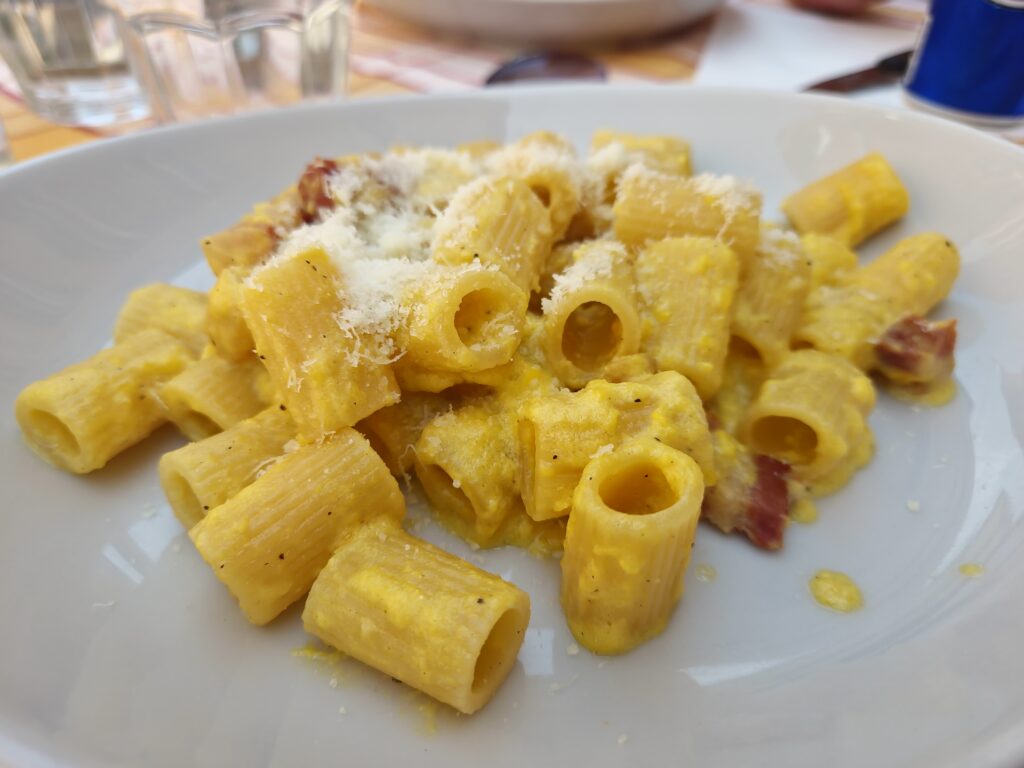
Our flights from Phoenix to Chicago and then on to Rome were thankfully uneventful. However, the Roman heat took us completely by surprise! We were unprepared for the sweltering 90°F with 80% humidity. Arriving around 9:30 am on August 15th, we foolishly decided to power through our jet lag and explore the city immediately. After nearly 24 hours without sleep, “hitting the ground running” proved to be a terrible idea. The combination of exhaustion and the oppressive heat and humidity led to heat exhaustion, despite my 20+ years of living in the Arizona desert. Clearly, the Italian heat is a different beast altogether!
8/16
The next day, I was completely knocked out by illness, a real shame as we were scheduled to see the Colosseum, Roman Forum, and Pantheon. We had to abandon our plans, and with them, our pre-purchased tickets, which just added to the frustration.
8/17
A visit to the Vatican City
Our Sistine Chapel tickets were for 2:30 pm, so we spent the morning exploring the exterior of the Colosseum and the Roman Forum. Even from the outside, these iconic structures were as impressive as we’d imagined. We were disappointed to have wasted our Colosseum tickets, which had been difficult to secure—we’d booked them a month in advance—but we made the most of our time exploring other sites.
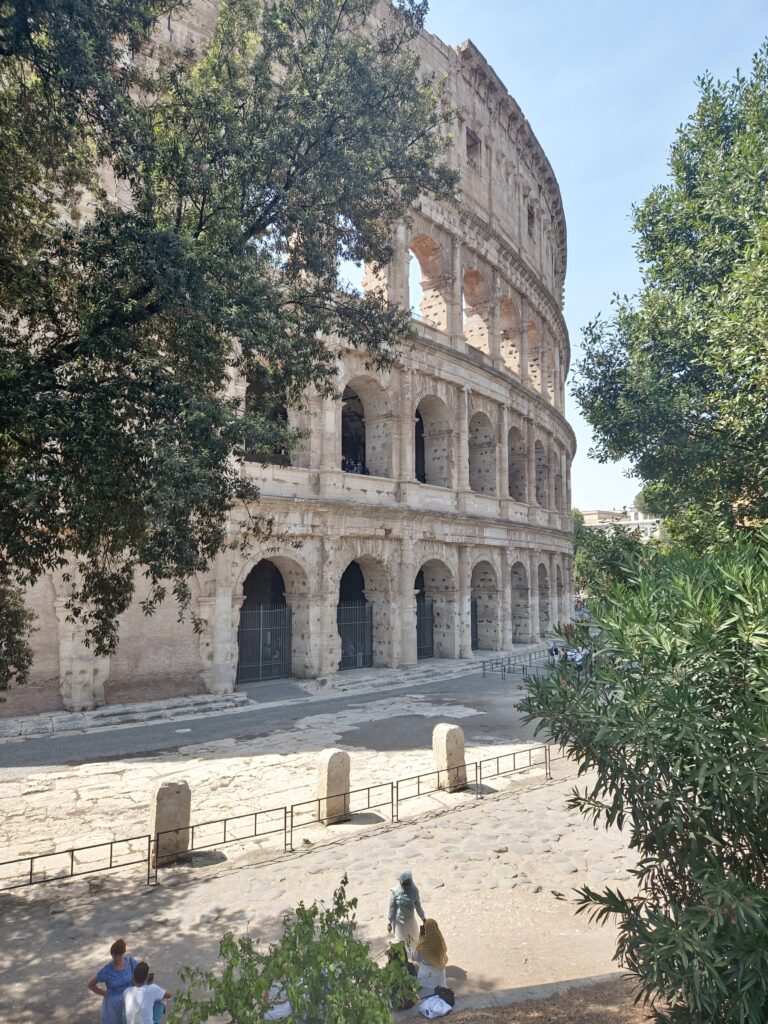

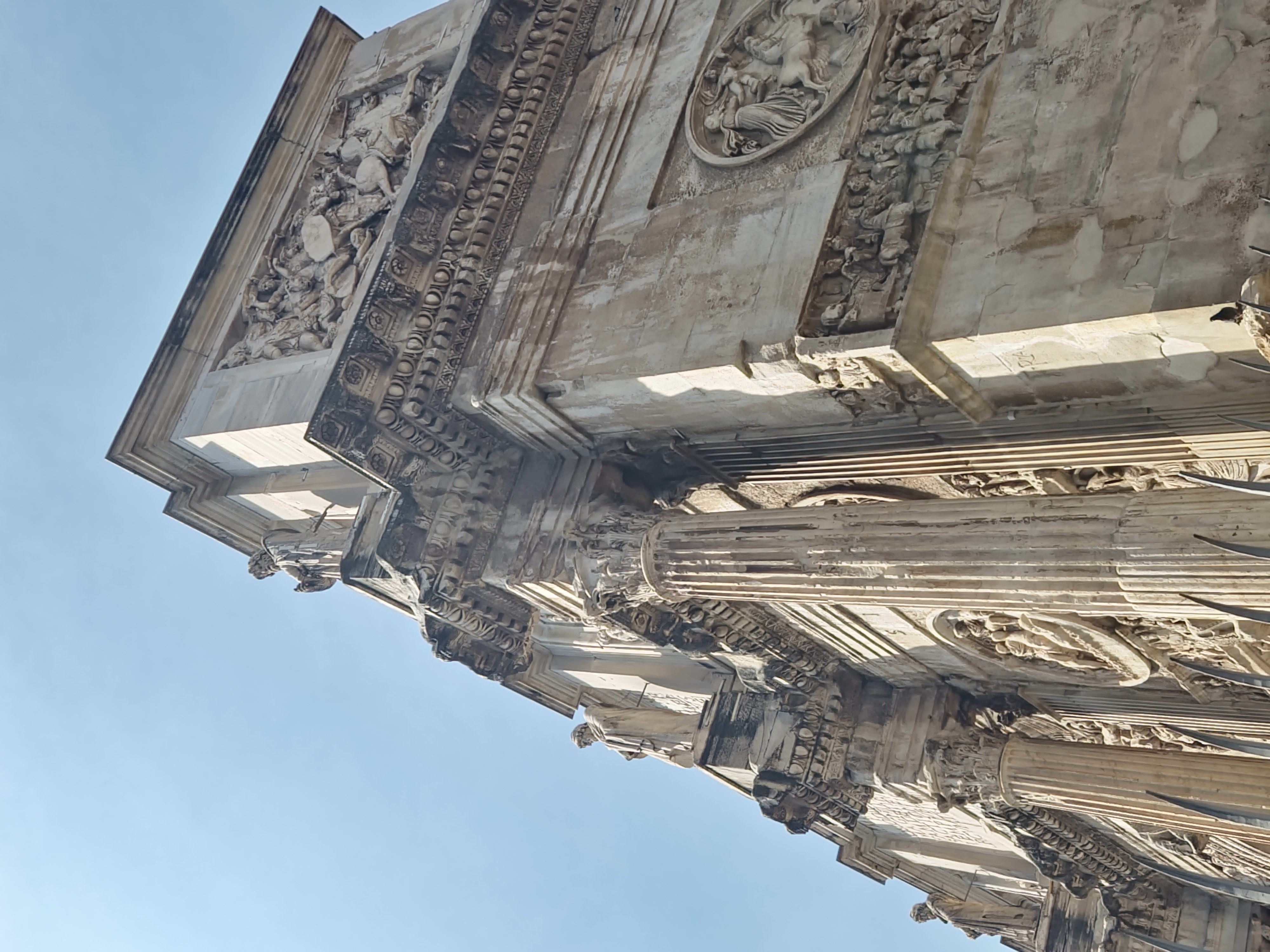
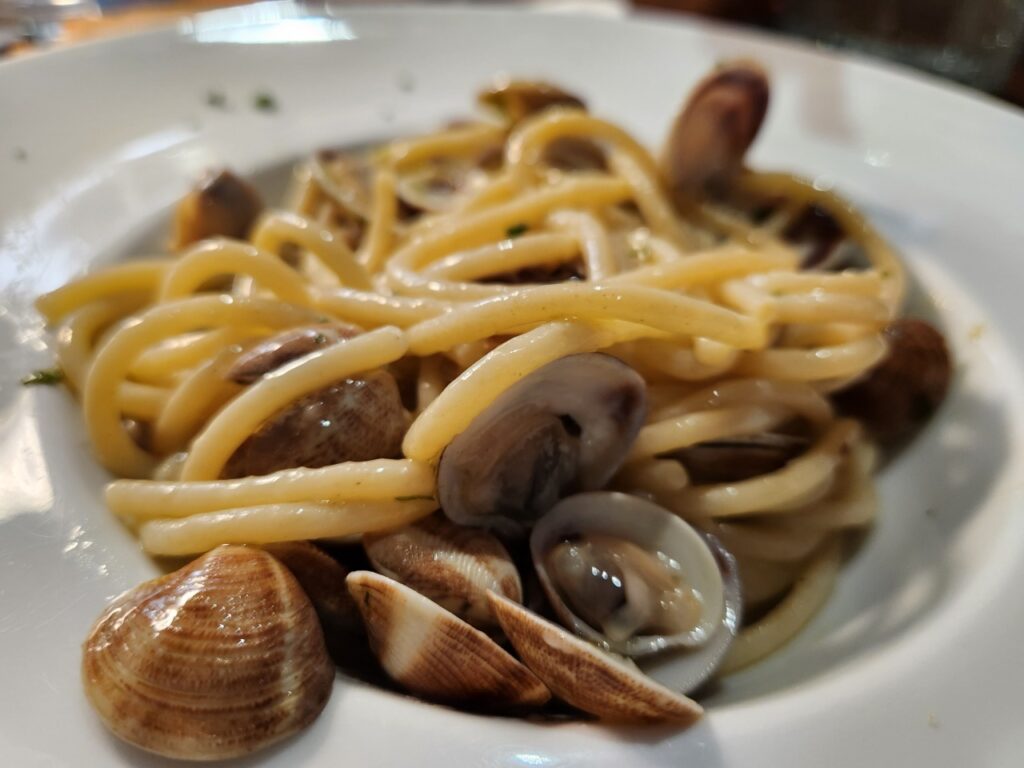
For lunch, we chose Hostaria I Clementini, a highly-rated restaurant on Google (4.4 stars with 1,328 reviews). The food was delicious, and the staff was incredibly friendly. We were hoping for a quick meal to get to the Sistine Chapel on time, but we quickly realized that European dining is a leisurely affair. While the food and service were excellent, the pace wasn’t ideal for our tight schedule. We briefly considered asking them to expedite our order but decided against it, not wanting to perpetuate the stereotype of rushed and demanding American tourists. We believe in being respectful travelers and try to avoid contributing to any negative perceptions.
By the time we finished lunch, it was almost 2:00 pm. Hailing a cab proved challenging, but fortunately, the restaurant owner, who recognized us when he stepped out for a smoke, came to our rescue. He thoughtfully asked the concierge at the neighboring hotel to call a taxi for us.
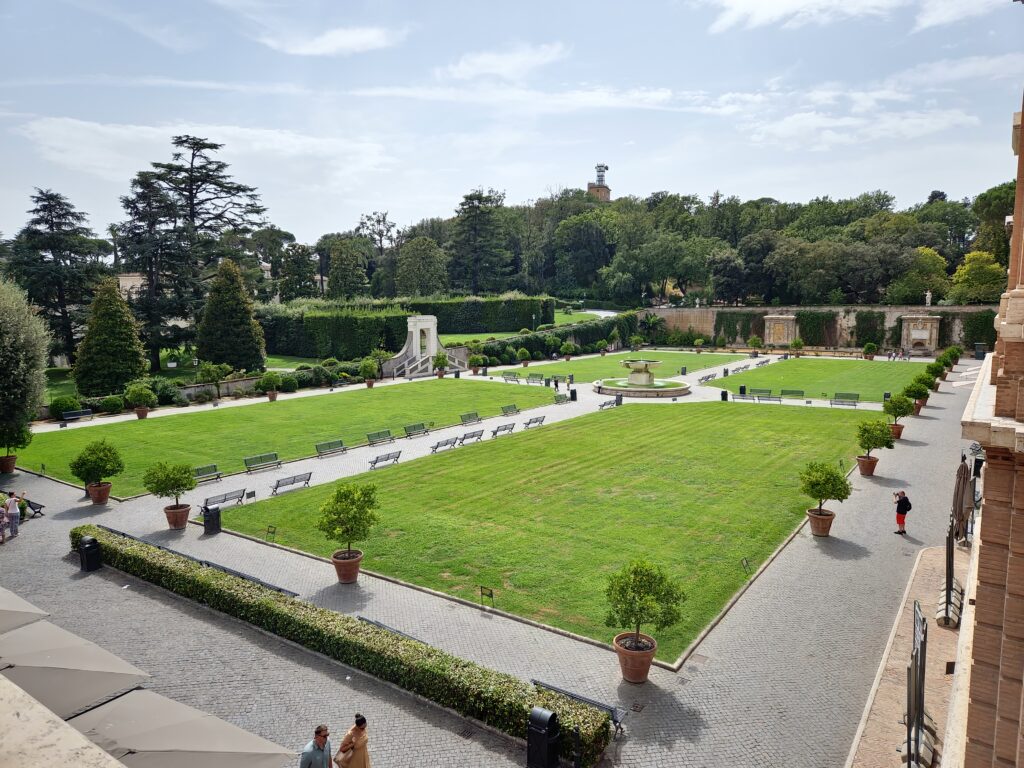
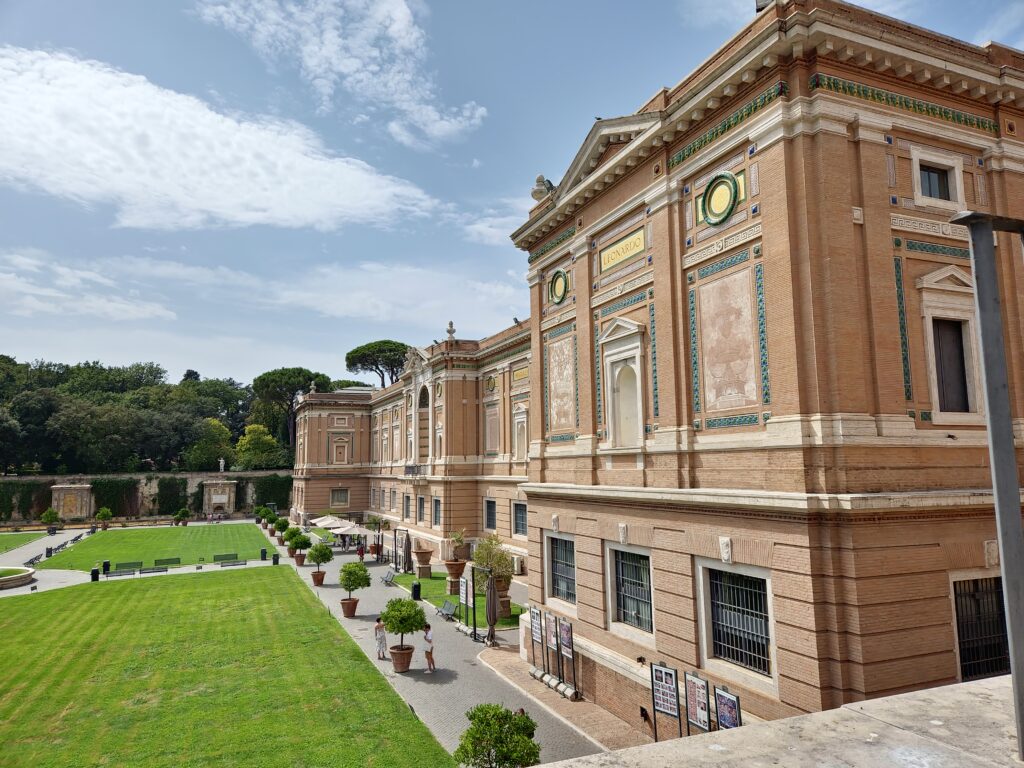

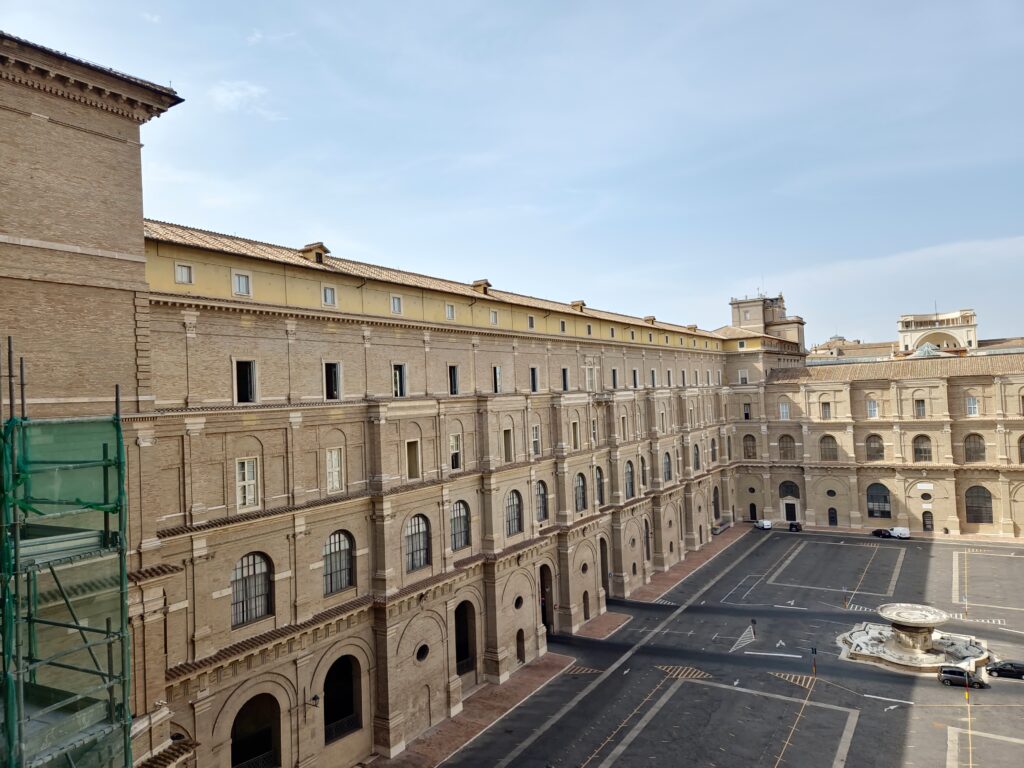
We finally arrived at the Vatican “border,” but it was well past 2:30 pm. We were concerned that our timed-entry tickets wouldn’t be valid. Here’s a pro-tip for visiting the Sistine Chapel: while regular tickets sell out quickly online, tour tickets (which aren’t significantly more expensive) are often still available. You don’t have to stay with the tour group; many people break away and explore on their own. While English tours are also popular, consider booking a tour in another language (like we did with Italian) if your primary goal is simply getting inside.
At the entrance, a long line awaited. Surprisingly, when we showed our tickets, the attendant waved us to the front! At the customer service desk, we were informed that the tour had already departed, but we were welcome to explore the Sistine Chapel on our own—exactly what we had planned to do after ditching the tour group anyway!
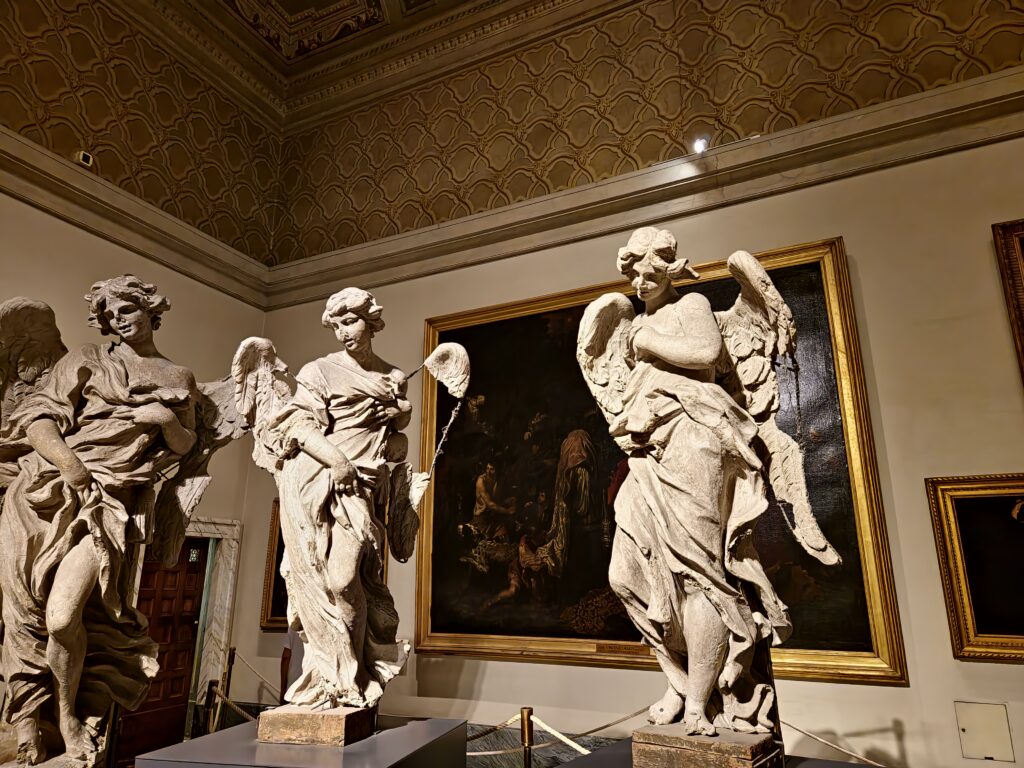
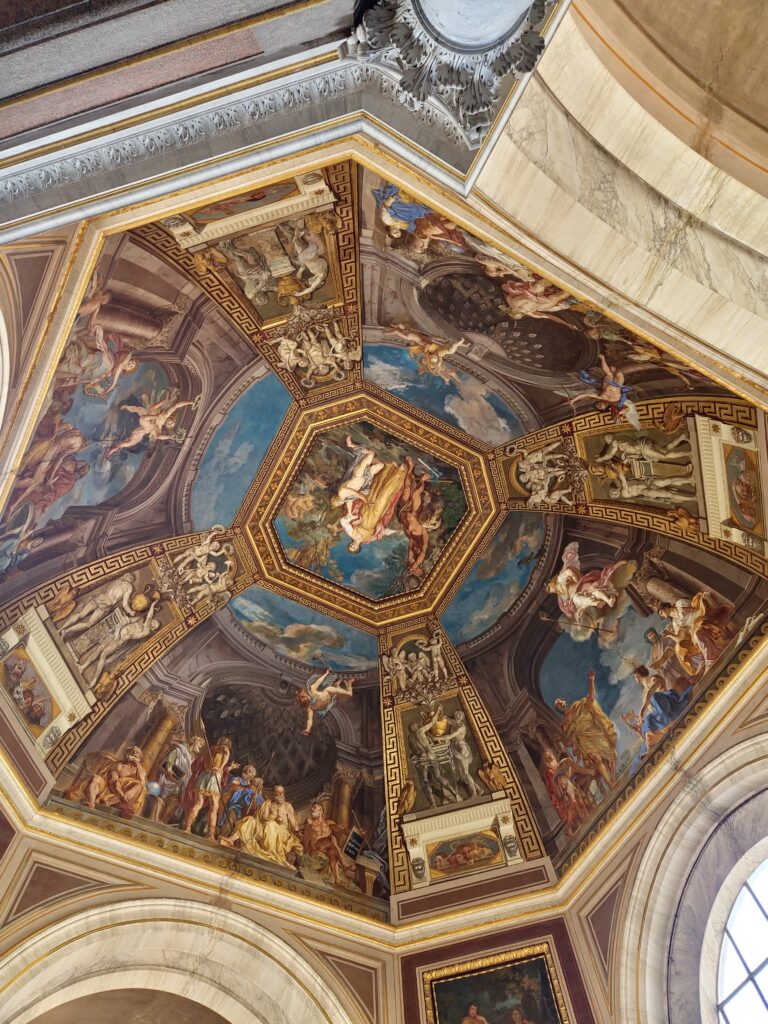
Inside Vatican City, the Sistine Chapel felt more like a museum than a traditional chapel. The sheer number of artifacts, paintings, sculptures, maps, and other treasures was astounding, not to mention the crowds of visitors. Navigating the many corridors filled with historical artifacts could have been overwhelming, but thankfully, clear directional signs helped us find our way. The most breathtaking aspect was undoubtedly Michelangelo’s ceiling. The artistry and the fact that it was painted upside down were truly awe-inspiring.
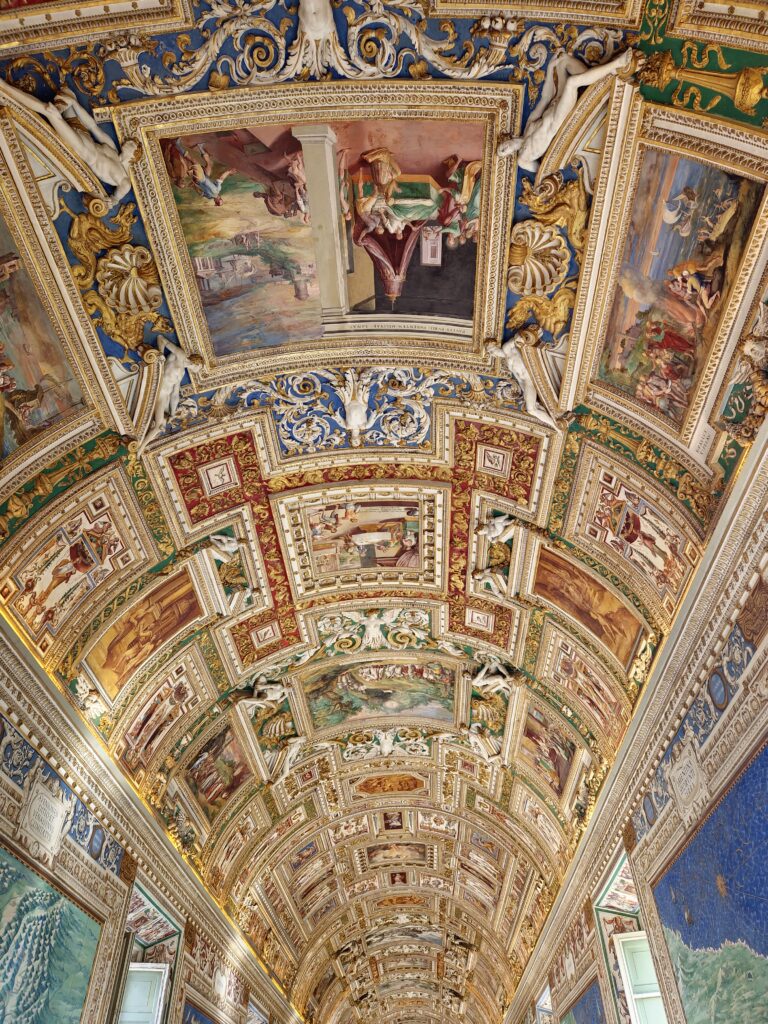
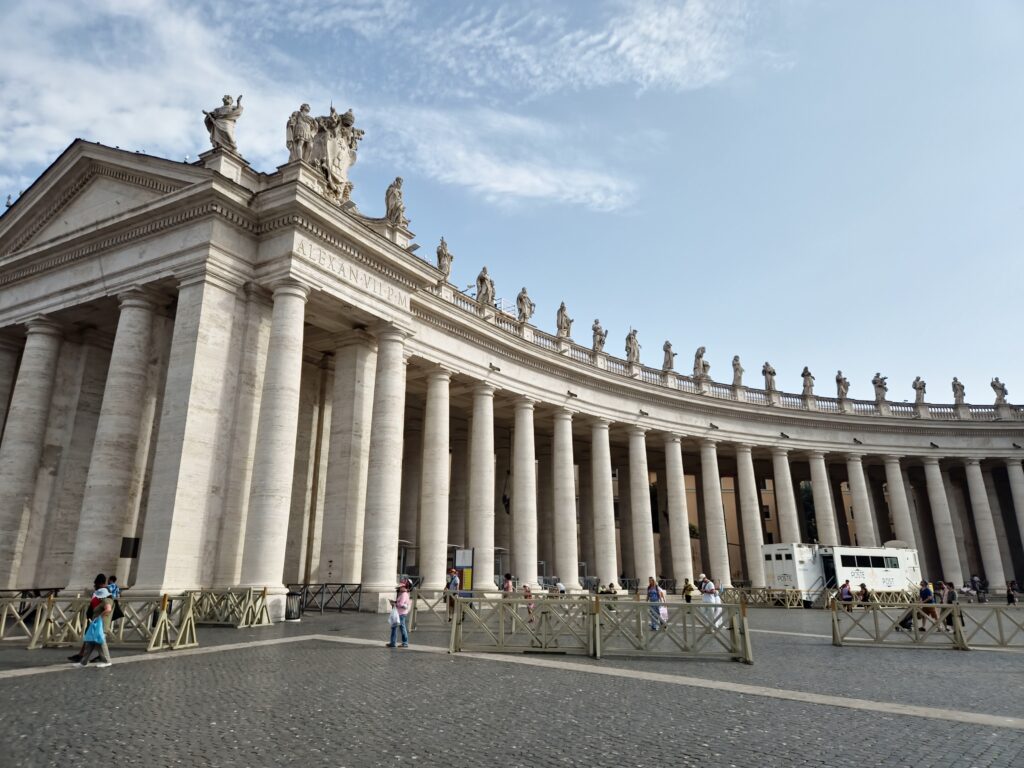
After the Sistine Chapel, we visited the famous Saint Peter’s Square, which lived up to its iconic reputation. Unfortunately, the line to enter Saint Peter’s Basilica snaked all the way around the square. The heat and the long wait discouraged us, so we decided to skip it this time. Perhaps we’ll visit again when the weather is cooler.
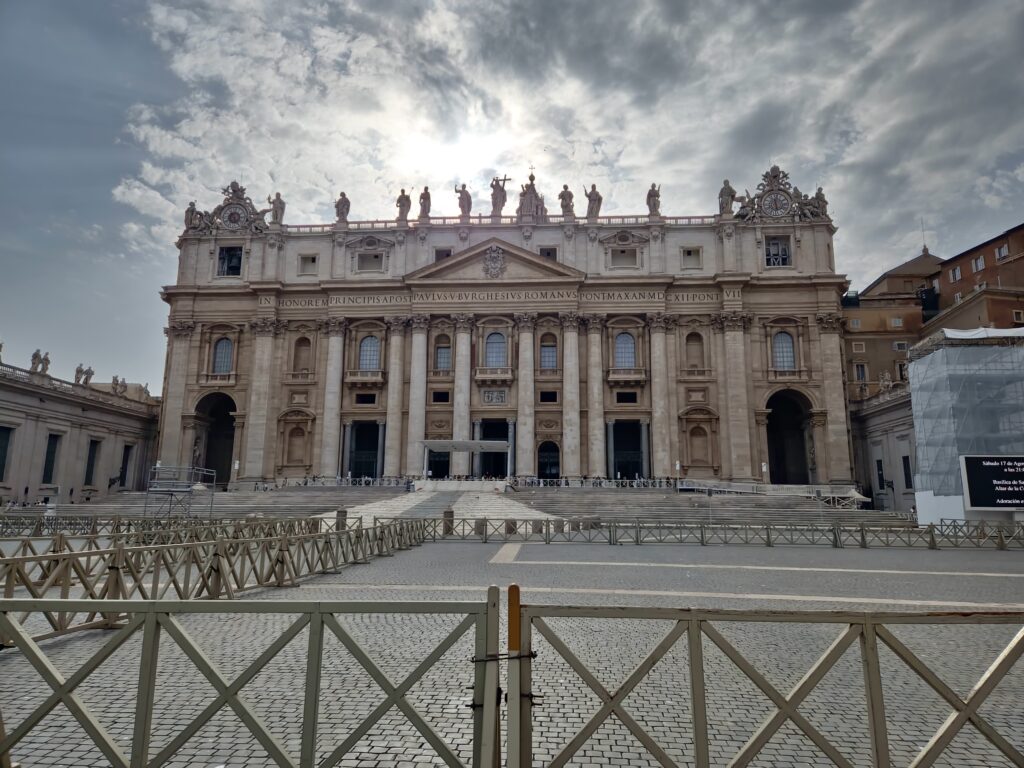
8/18
Road to Leece
Our five-hour train journey from Rome to Lecce was comfortable and uneventful, a smooth transition to our next destination. Arriving at Lecce station, we were just a ten-minute walk from our Airbnb, nestled within the ancient walls of the old town. Despite the lingering heat and humidity, we were eager to explore.
Stepping through the gateway into Lecce’s old town felt like stepping back in time. The atmosphere shifted dramatically, the ancient architecture and cobblestone streets transporting us centuries into the past. While the uneven cobblestones weren’t ideal for rolling suitcases – a modern invention, after all – they added to the charm. The experience was a world away from bustling Rome. Here, the narrow, winding streets formed a captivating labyrinth, each turn revealing another glimpse of history. Buildings huddled close together, whispering tales of the past, and the weight of two thousand years of history was palpable.
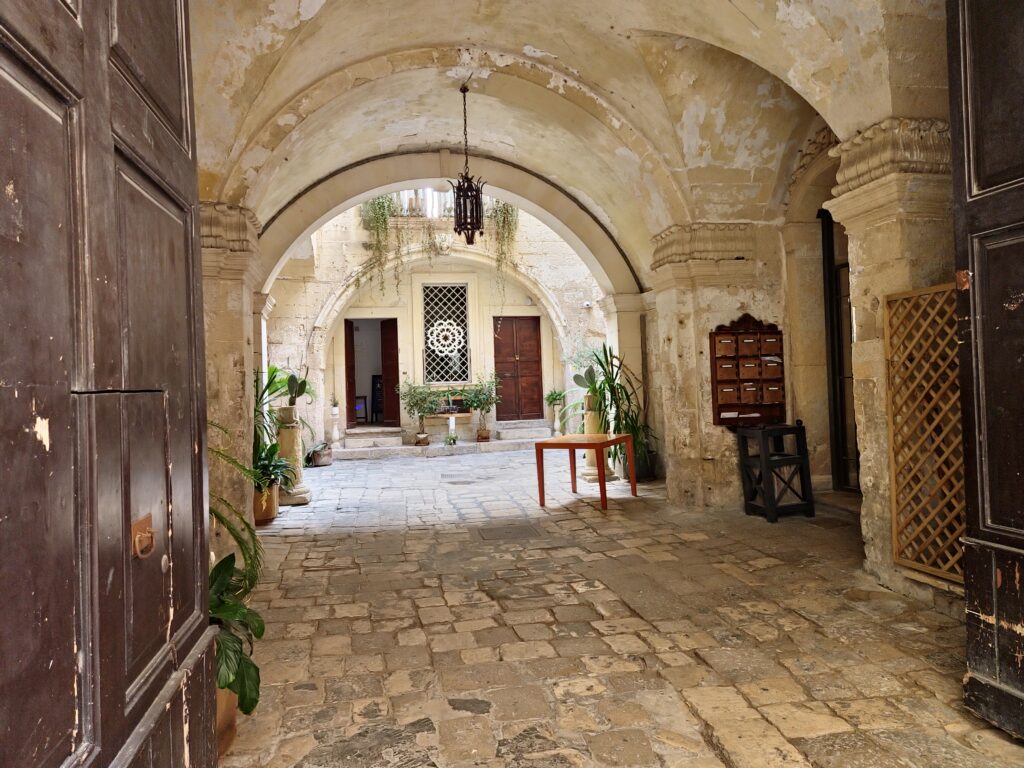
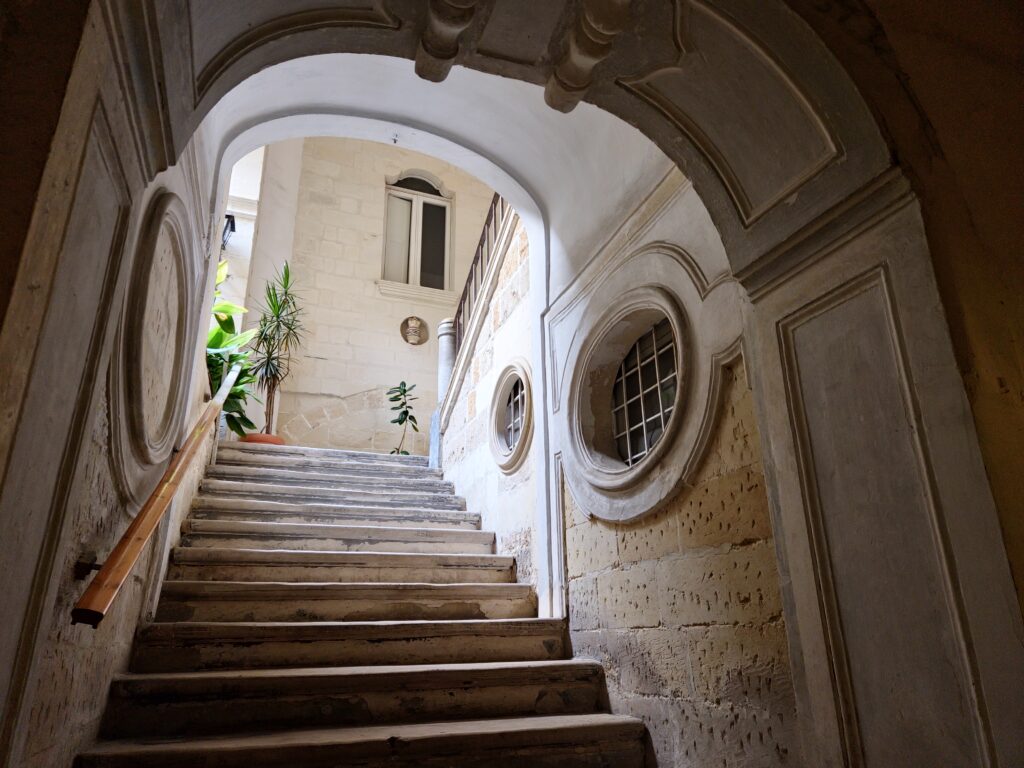
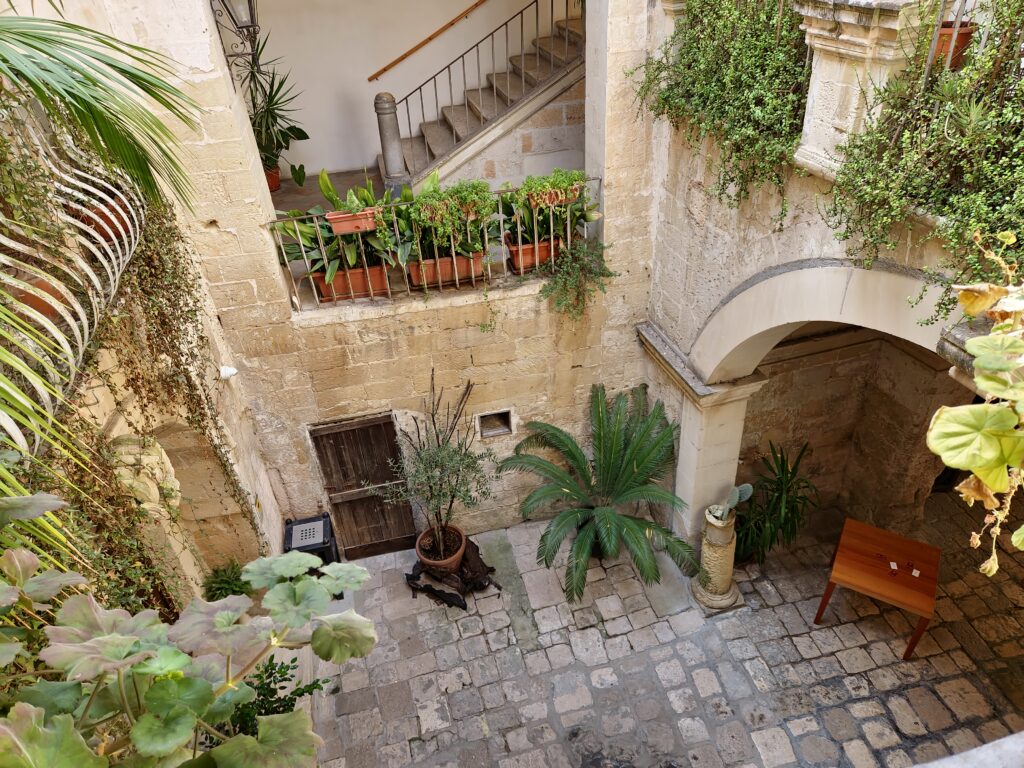
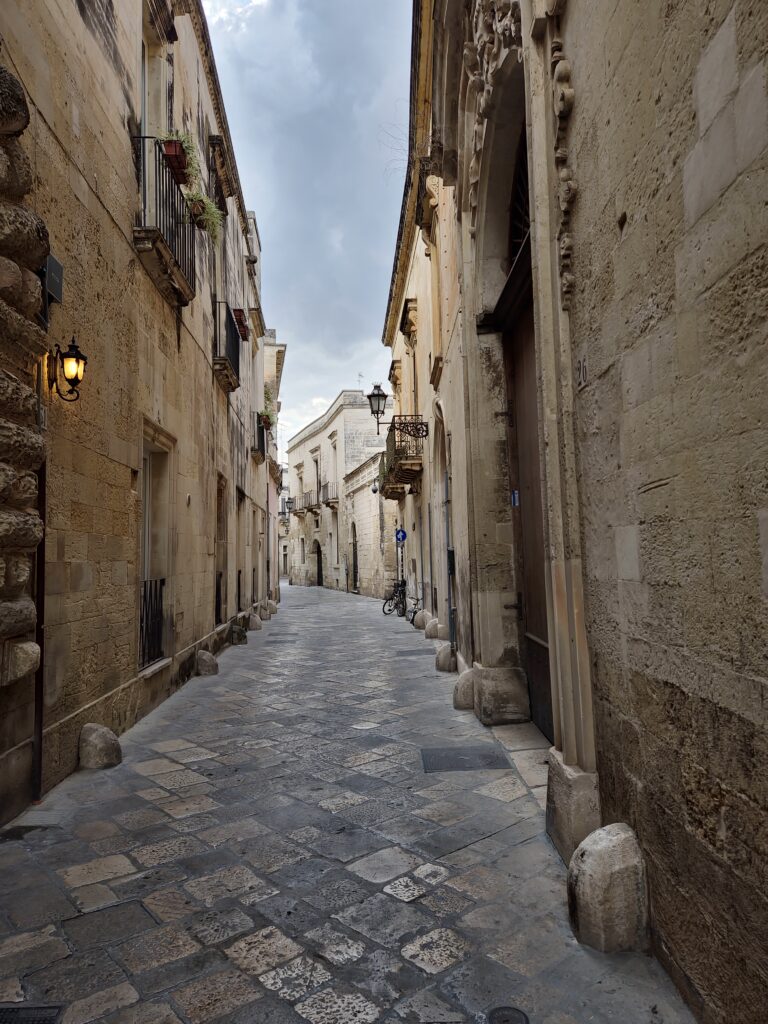
Lecce is often called the “Florence of the South,” renowned for its historical and architectural treasures, particularly its Baroque architecture, churches, and palaces. While I can’t yet compare it to Florence firsthand, I look forward to the day I can.
This trip to southern Italy is a scouting mission, a chance to explore potential future homes. We dedicated five days to Lecce and its surrounding beach towns, hoping to identify a few promising areas.
Our first excursion was to San Cataldo, the closest beach town to Lecce, accessible by a direct 30-minute bus ride. Unfortunately, our timing couldn’t have been worse. The weather turned foul, with relentless wind and increasing cloud cover. The scenery en route to San Cataldo was also a bit disappointing. Beyond Lecce, the area felt somewhat neglected, with a growing number of condos appearing closer to San Cataldo, many of which looked abandoned. While some may have been occupied, they certainly didn’t convey a welcoming impression.
As the weather deteriorated, with rain joining the wind, we made the disappointing decision to remain on the bus upon reaching San Cataldo. We simply turned around and headed back to Lecce, the trip a complete washout.
8/20
Gallipoli…
Gallipoli: The Spark for Our Italian Adventure!
Just a few months ago, our Italian adventure began with a simple YouTube video. We were watching real estate showcases when we stumbled upon a video featuring Gallipoli, a charming beach town in Puglia. Neither of us had ever heard of Puglia, let alone Gallipoli, but the video captivated us. The town looked stunning, and I personally loved the name. That single video ignited a spark, and we immediately started planning our first trip to Italy, focusing on the Puglia region.
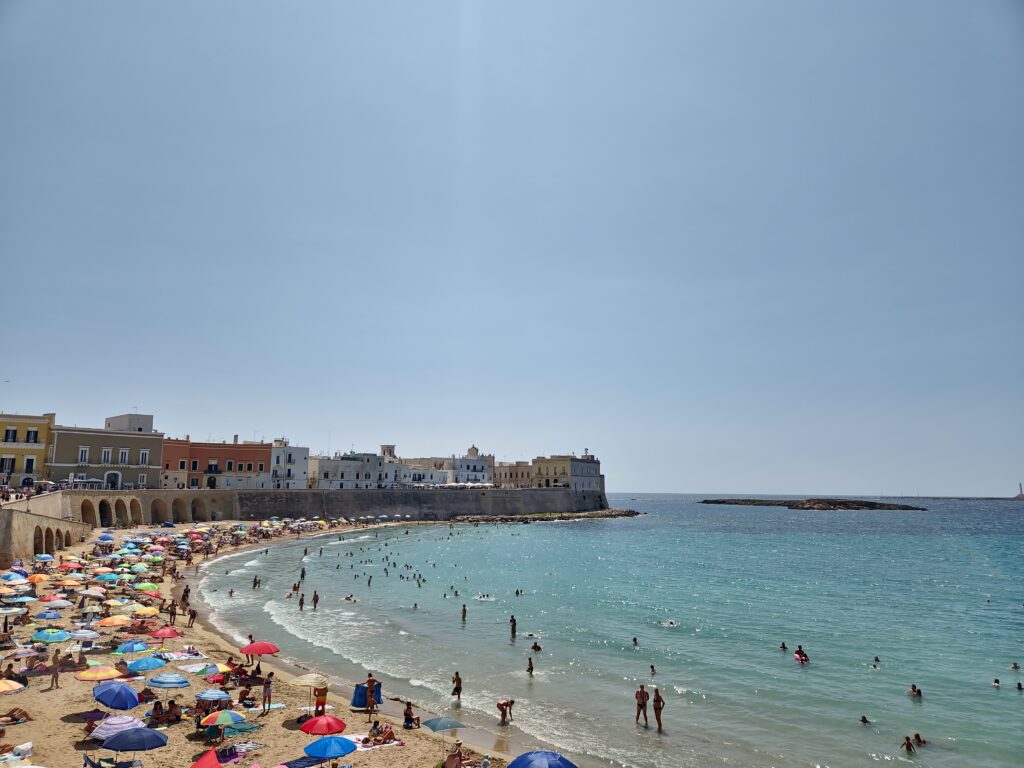
Gallipoli itself seemed to have everything we were looking for: a beautiful historic center, a vibrant restaurant scene, and, according to Google Maps, plenty of beaches. However, we soon encountered our first challenge. We’d decided to travel without a car on this trip, wanting to experience Italy using public transportation. Gallipoli quickly proved to be a difficult destination to reach without a vehicle. The closest bus station was a good 30-minute walk from the town center, making it less accessible than we had hoped. In addition to the obstacle, almost all of the beaches were not accessible by foot. Needless to say that it was a discouraging revelation when Gallipoli was on the very top of our list. I’m not saying it’s bad, it would be great if we had a car.
8/21
Monopoli and Polignano a Mare!
Monopoli was our second eagerly anticipated beach town, and honestly, the name alone sparked our excitement. I couldn’t resist the playful connection, joking that Monopoli must be Monopoly’s charming Italian cousin! Unlike the more challenging journey to Gallipoli, Monopoli proved wonderfully accessible by train. A comfortable hour-plus ride from Lecce brought us directly to the Monopoli station. From there, we opted for a leisurely walk to Lido Pantano, our chosen beach, a mere 19 minutes away (or a quick 17-minute bus ride). The walk, while not picturesque, offered a glimpse into everyday life, winding through residential and business districts. We felt like temporary locals, far removed from the typical tourist trail.

Monopoli boasts a wealth of beaches, and Lido Pantano’s proximity to the station made it the perfect choice for our day trip. As we discovered, Italian beaches generally fall into two categories: “lidos” and “spiagge.” Lidos, like Pantano, are private, serviced beaches where you pay for amenities like umbrellas, chairs, and concessions. Spiagge, on the other hand, are public and free. While the idea of paying for a beach might seem counterintuitive, especially with free options available, the convenience of a lido is undeniable for travelers. For a day trip, the €40 total we paid at Lido Pantano, arriving in the afternoon, was a worthwhile investment. It eliminated the hassle of purchasing and carrying our own beach gear, allowing us to fully relax and enjoy the experience. Typically, lidos can cost €60 or more per person for a full day, so the afternoon discount was a pleasant surprise.
Polignano a Mare
Polignano a Mare held a delicious mystery for us. We knew of the iconic cove, the cliffside buildings clinging to its edges – those postcard-perfect images that dominate any online search. But nothing truly prepares you for experiencing it firsthand. Our day at the beach ran long, leaving us to explore Polignano under the cloak of dusk. While daylight photos might showcase its vibrant colors, the twilight cast a spell, transforming the town into a scene of pure magic and romance.
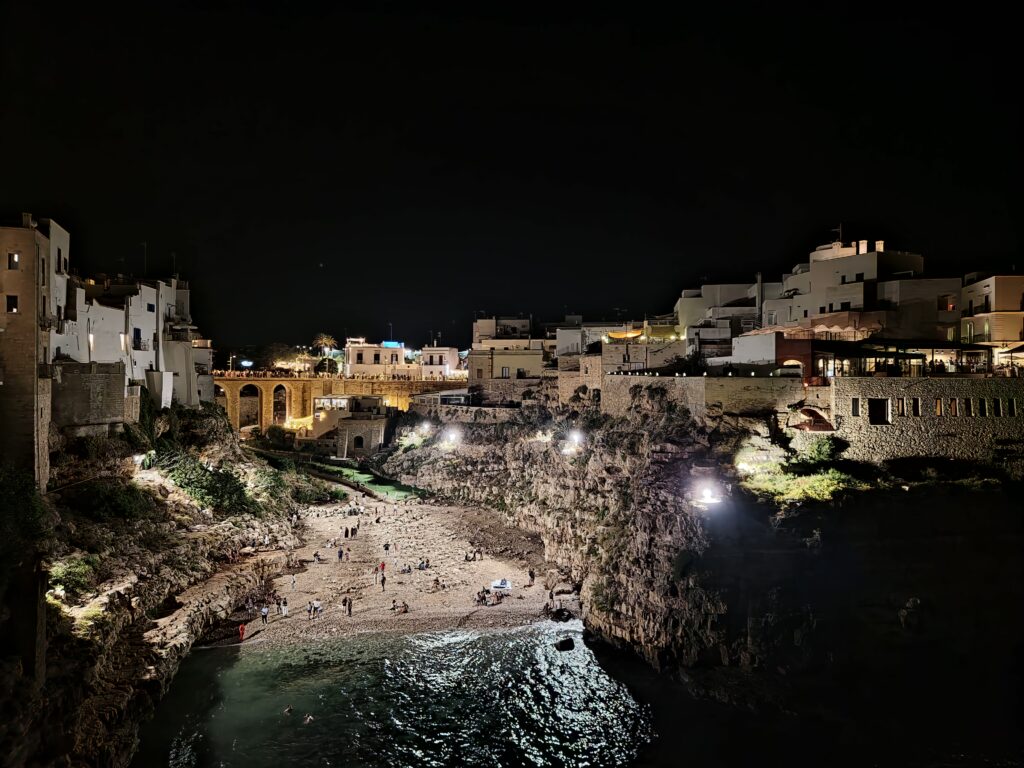

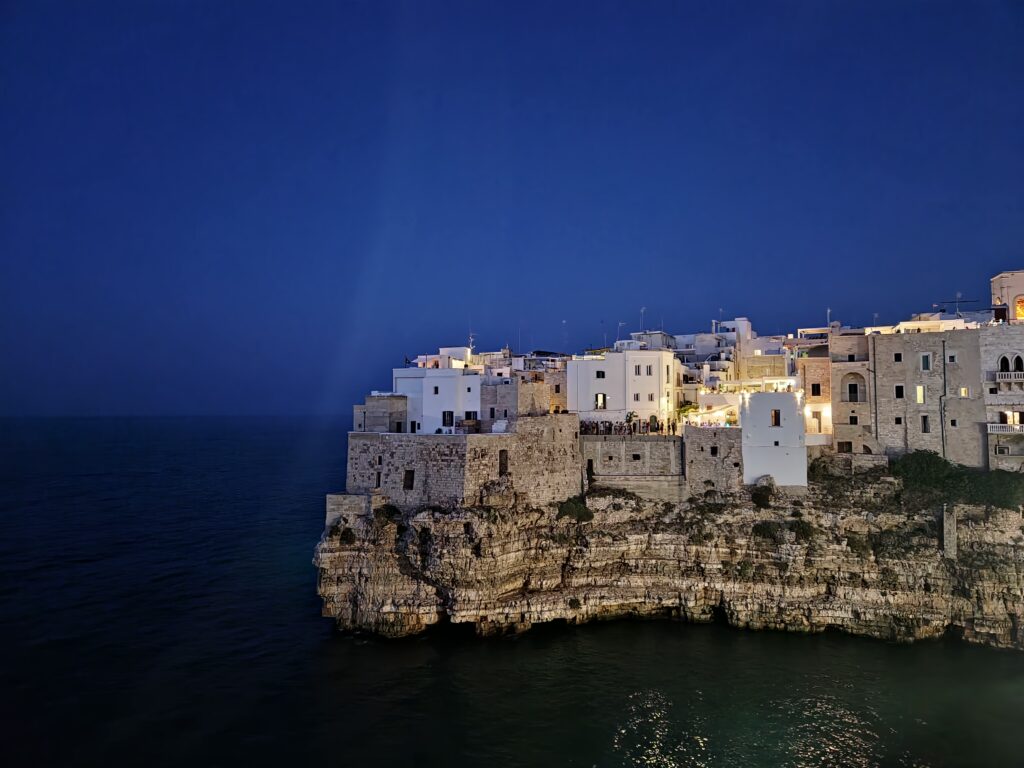
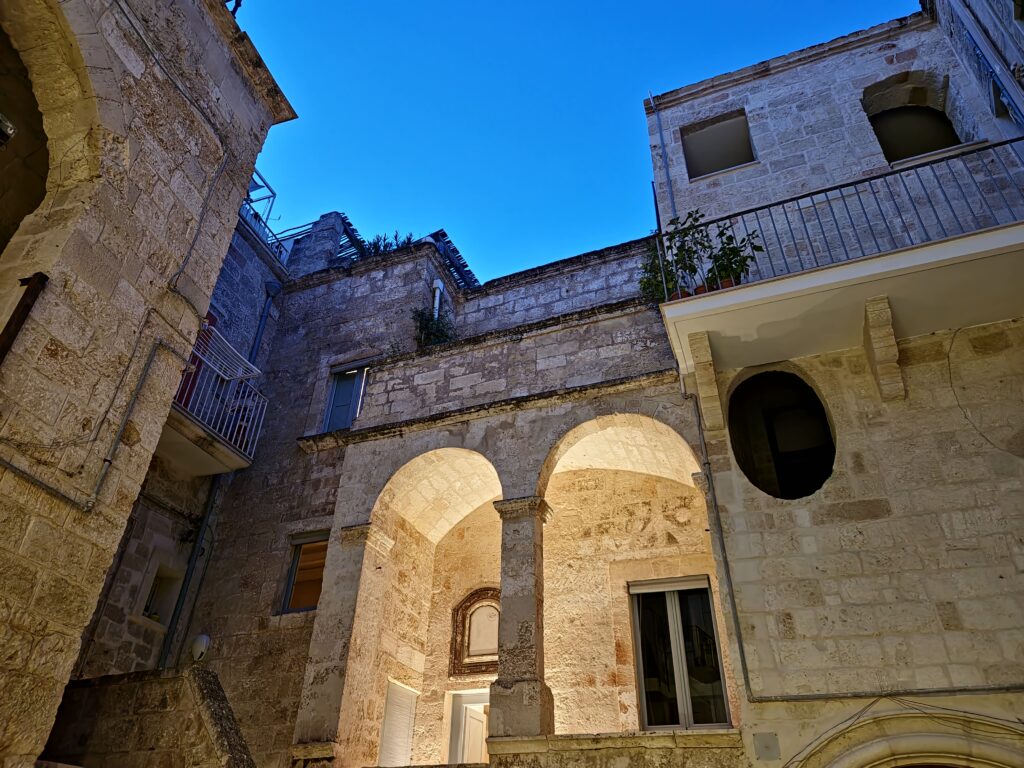
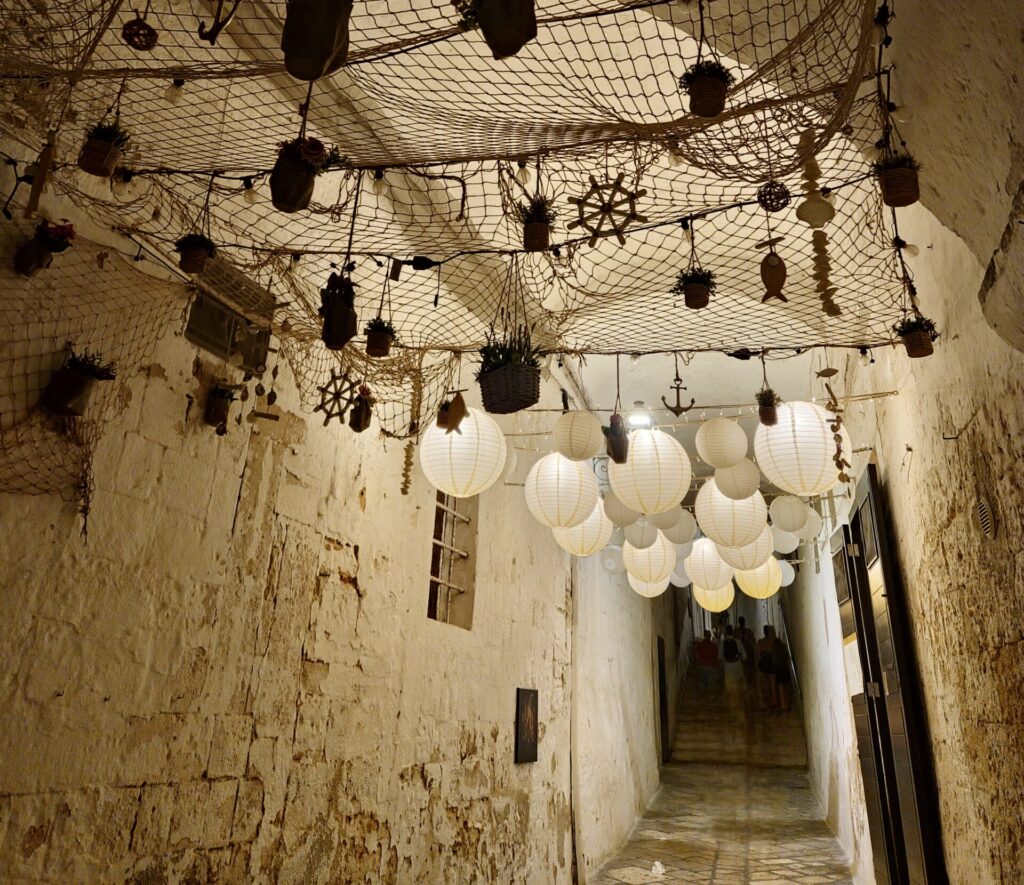
Every cobblestone corner and sun-drenched vista in Polignano a Mare feels plucked from a storybook. It’s astonishing to think this place, with its breathtaking beauty, has witnessed millennia, dating back to ancient Greek settlements.
We’d imagined a quick stop, a mere photo opportunity. Little did we know, Polignano a Mare is a living, breathing town, pulsing with life. A short, five-minute train hop from Monopoli and a leisurely seven-minute stroll from the station transported us into its heart. Instantly, it felt as though we’d stepped into a different era, much like our experience in Lecce. The ancient cobblestone streets narrowed, the charming houses huddled closer, and we surrendered to the joy of wandering, letting the winding paths guide us.

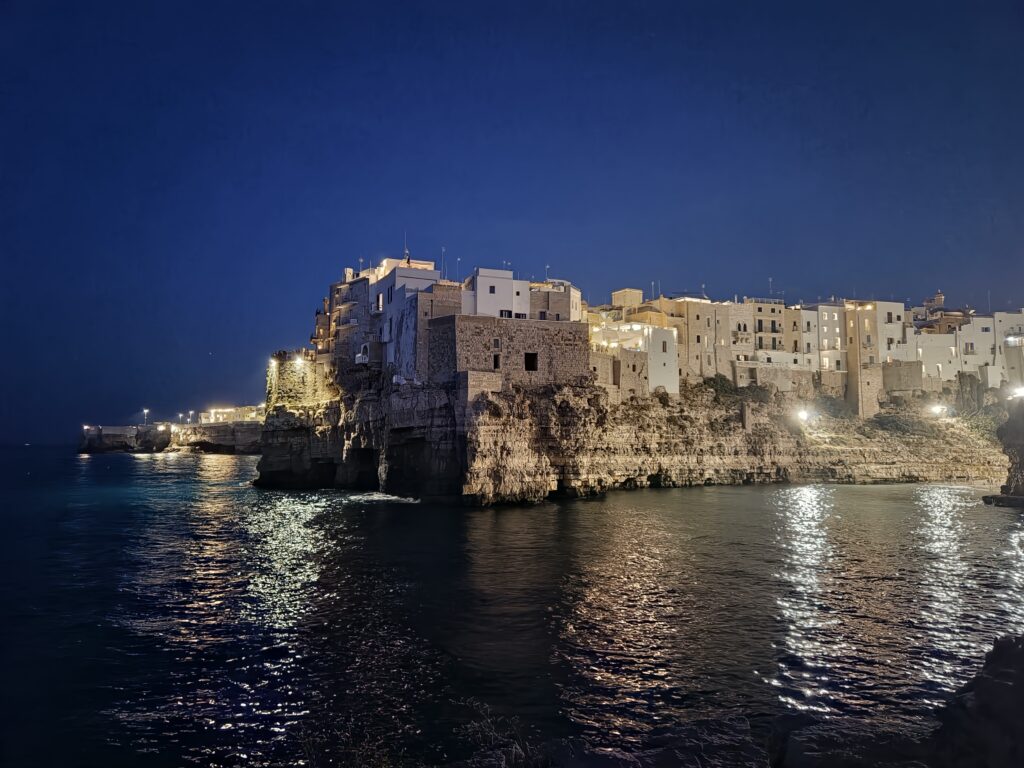
Even at night, Polignano a Mare throbbed with energy, a vibrant hub of activity. While undeniably popular, it lacked the frenetic, overwhelming atmosphere of typical tourist hotspots like the Colosseum or Trevi Fountain. Instead, it felt like a beloved local destination, a place where residents flocked for an evening of good food and convivial company. Yes, tourists mingled with street vendors and artists, but the ambiance remained relaxed, a gentle hum rather than a chaotic roar.
8/23
Otranto
Imagine a fortress embracing a vibrant town within its walls – that’s Otranto, a spectacle best appreciated from above. From an aerial view, the ancient castle reveals itself as a guardian, sheltering a maze of charming streets and sun-kissed piazzas. Below, the Adriatic shimmers in breathtaking turquoise, rivaling the beauty of any postcard. Otranto marked the culmination of our exploration of three coveted seaside gems.
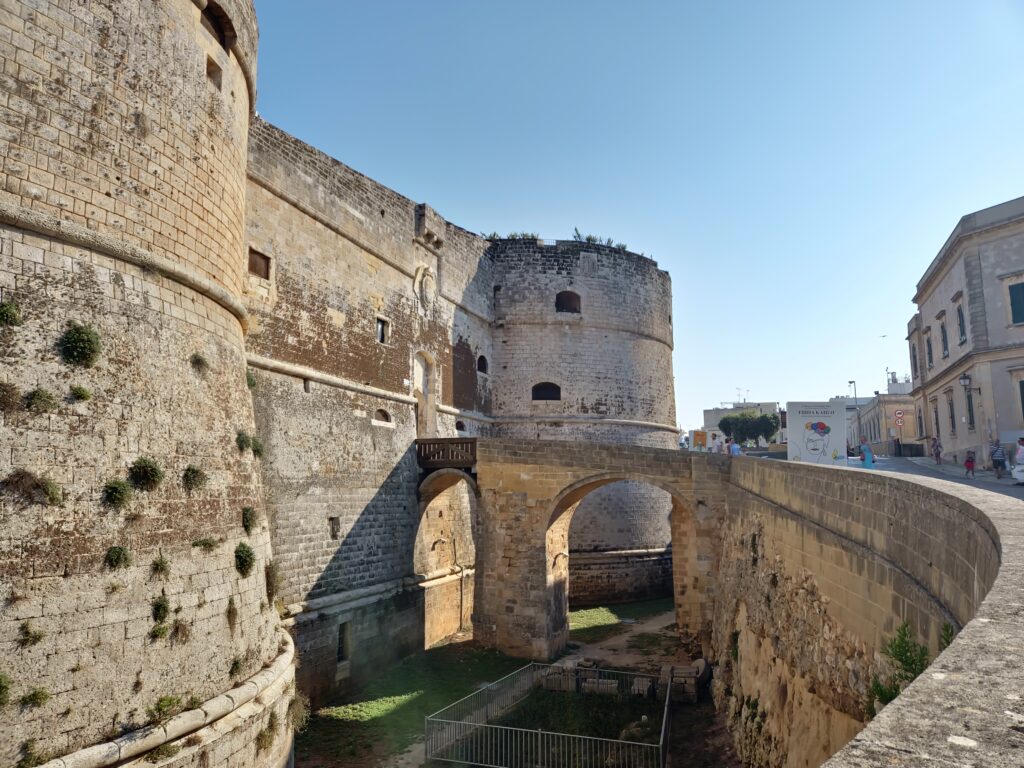
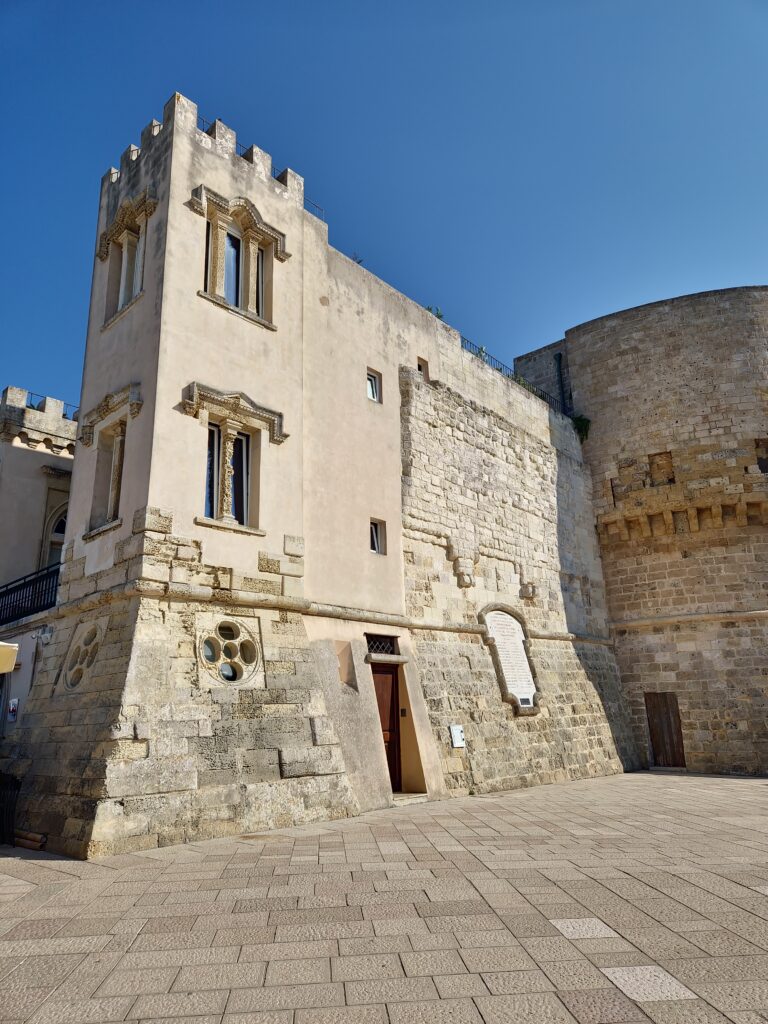
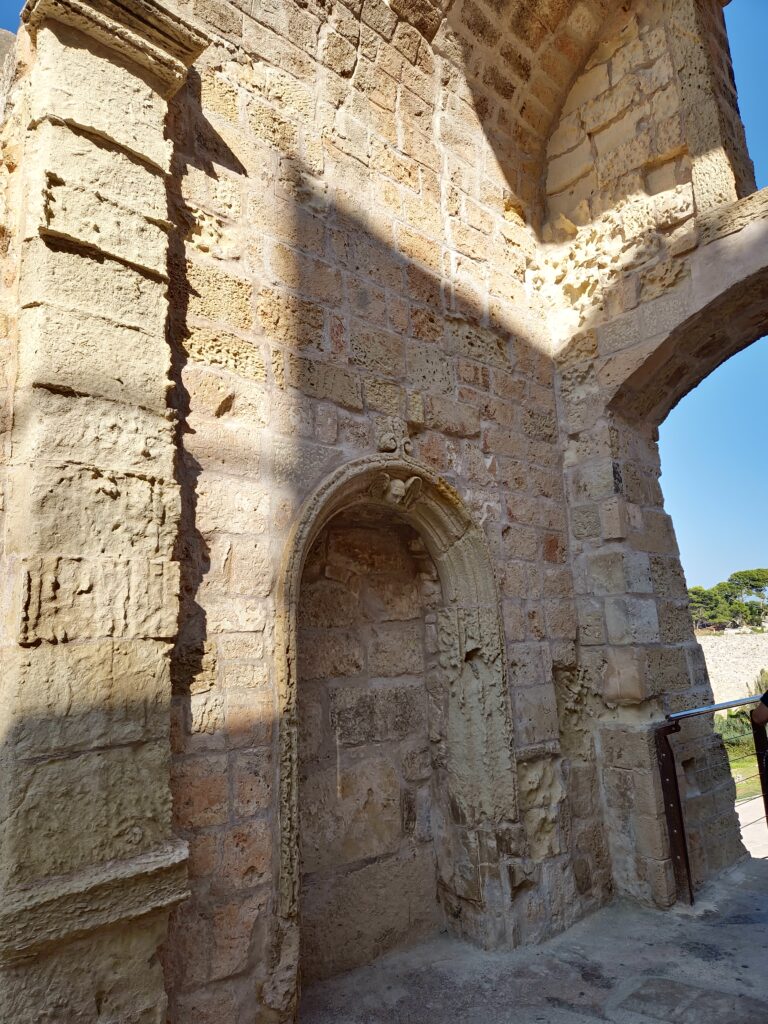
Our journey from Lecce, a scenic hour-long bus ride through Maglie, culminated in Otranto’s captivating embrace. The historic heart of the town, perched atop a gentle incline, beckoned us upwards. Winding cobblestone streets, reminiscent of Polignano a Mare, unfolded, revealing a delightful array of artisan shops and inviting restaurants
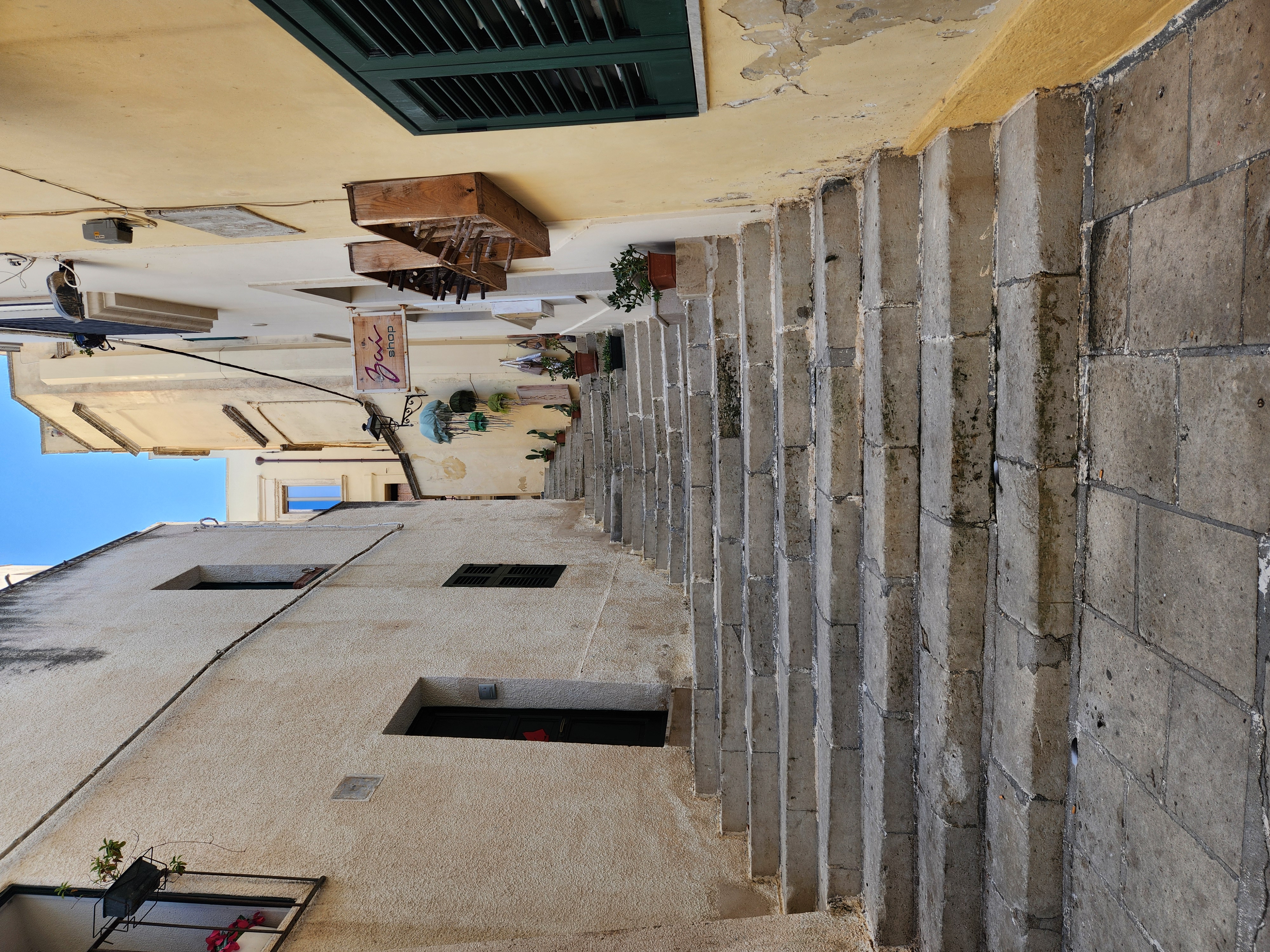

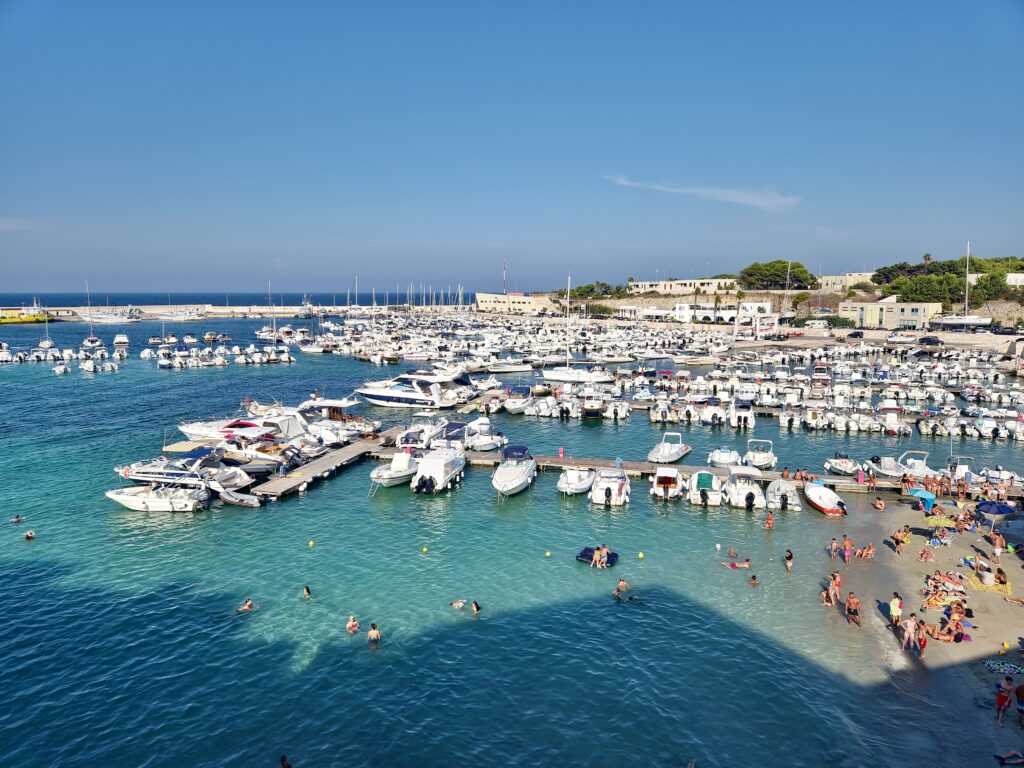
From the castle’s heights, a panorama of life unfolded: families basking in the sun, children splashing in the shallow lagoon that hugged the fortress walls. And then, there was SoFish. This unassuming 4.4-star gem delivered an unforgettable culinary experience – a lobster roll that redefined value. For a mere 25 Euros, we indulged in a whole lobster, artfully presented with half nestled within the roll and the other crowning it. A price unthinkable back home.

Otranto’s charm is undeniable. It’s a serious contender, perhaps even a challenger, to Polignano a Mare in our quest for the perfect seaside retirement haven.
8/24
Colosseum and the Roman Forum
As I’ve mentioned earlier the Roman sun, a relentless force, had won. Heat exhaustion strucked me down a few days ago, forced us to cancel our long-anticipated tour of the Colosseum and Roman Forum. A wave of disappointment washed over me. How could we possibly visit Italy and miss these iconic monuments? It felt like a fundamental part of the journey had been ripped away. The Colosseum, a symbol of ancient power, and the Roman Forum, the very heart of the Republic – they were non-negotiable.
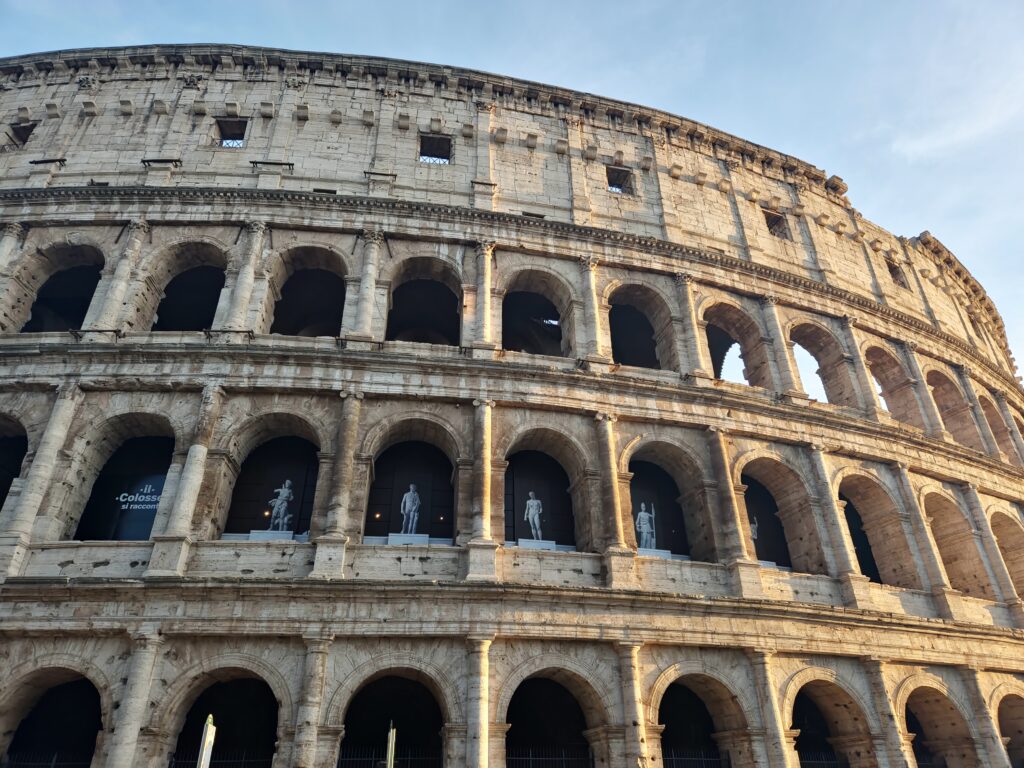
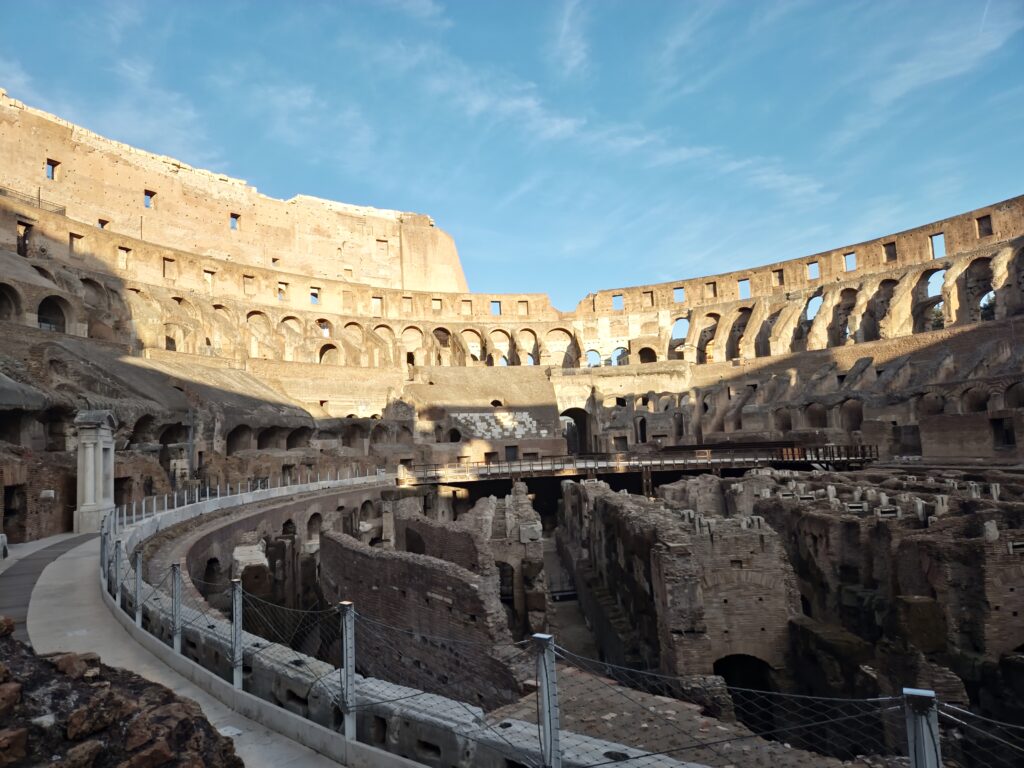
I resolved to try again. ‘We have to see them,’ I insisted, even though tickets were notoriously difficult to secure. Thirty days prior, I’d diligently booked online, only to find the ’24hr Arena’ tickets, a limited experience. These tickets allowed access to a platform overlooking the Colosseum’s hypogeum, the intricate network of tunnels beneath the arena floor. We could peer down at the ancient stagecraft, imagining gladiators and wild beasts, but we couldn’t actually walk upon the legendary arena floor itself. It was akin to glimpsing a masterpiece through a window, rather than immersing ourselves within it.

Two days ago, a flicker of hope ignited. On a whim, I checked the official ticket website again. To my utter astonishment, full tour tickets were available! Not just any tickets, but the coveted ones that allowed us to walk on the Colosseum, to feel the weight of history beneath our feet. This was a dramatic upgrade, a second chance granted by some stroke of fortune.
For anyone planning a visit to Rome, let this be a lesson: don’t despair if tickets seem sold out weeks in advance. Regularly check the official websites, as cancellations and releases can occur. You might just find the tickets you desire when you least expect it.
Furthermore, if online booking proves fruitless, don’t abandon hope. On-site ticket purchases are still possible, albeit with potential queues. However, here’s a crucial insider tip: bypass the notoriously long lines at the Colosseum’s main ticket office. Instead, head to the entrance of the Roman Forum. There, a lesser-known ticket booth awaits, often with significantly shorter lines. Most visitors, drawn by the Colosseum’s imposing presence, are unaware of this alternative. This hidden gem can save you precious time and energy, allowing you to fully appreciate the wonders of ancient Rome.
Our experience transformed from a potential disaster to a triumphant exploration. We walked the Colosseum’s arena, imagining the roar of the crowd, and wandered through the Roman Forum, picturing the bustling life of the Republic. It was a reminder that even when travel plans falter, perseverance and a little insider knowledge can lead to unforgettable experiences.”
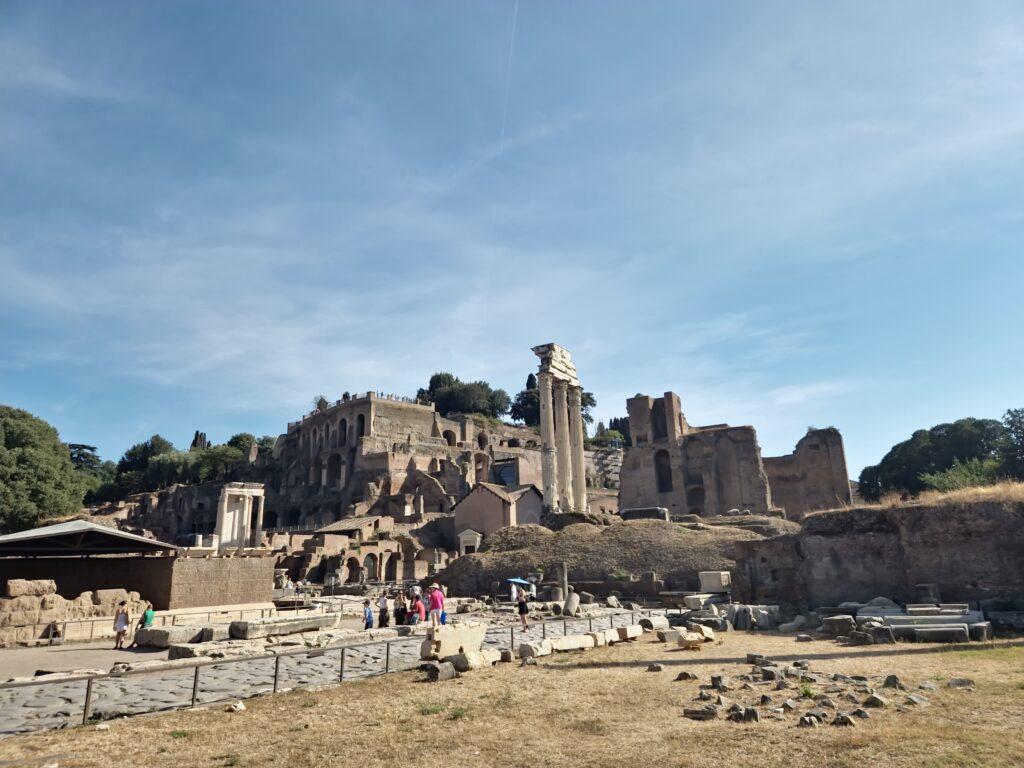
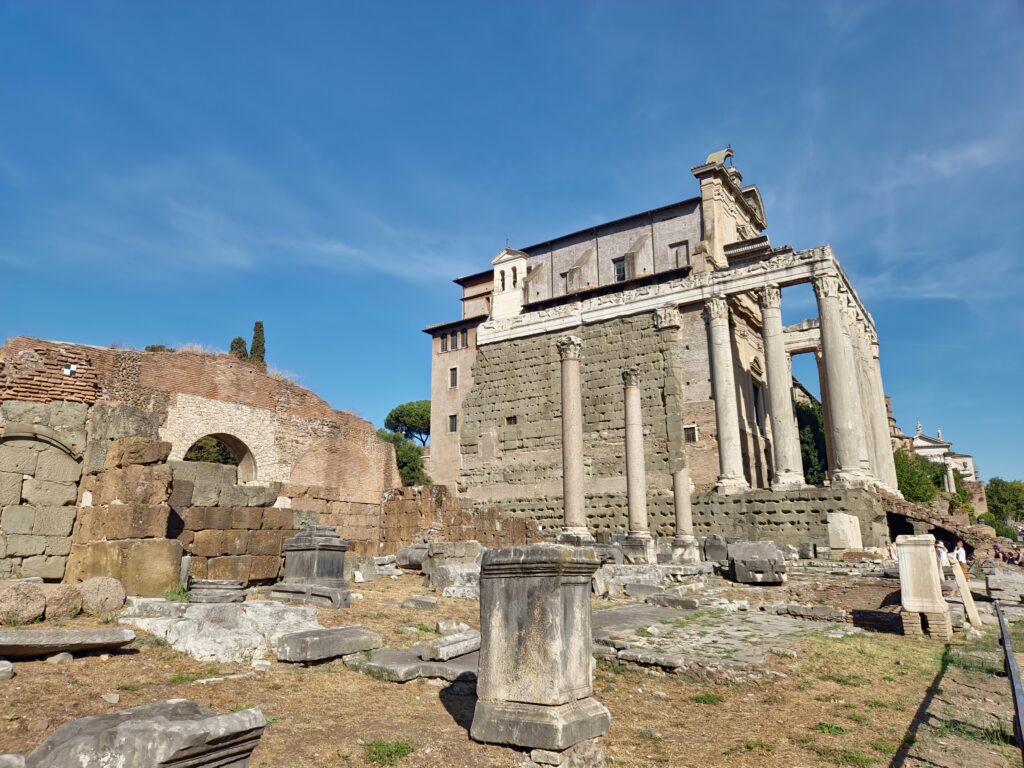
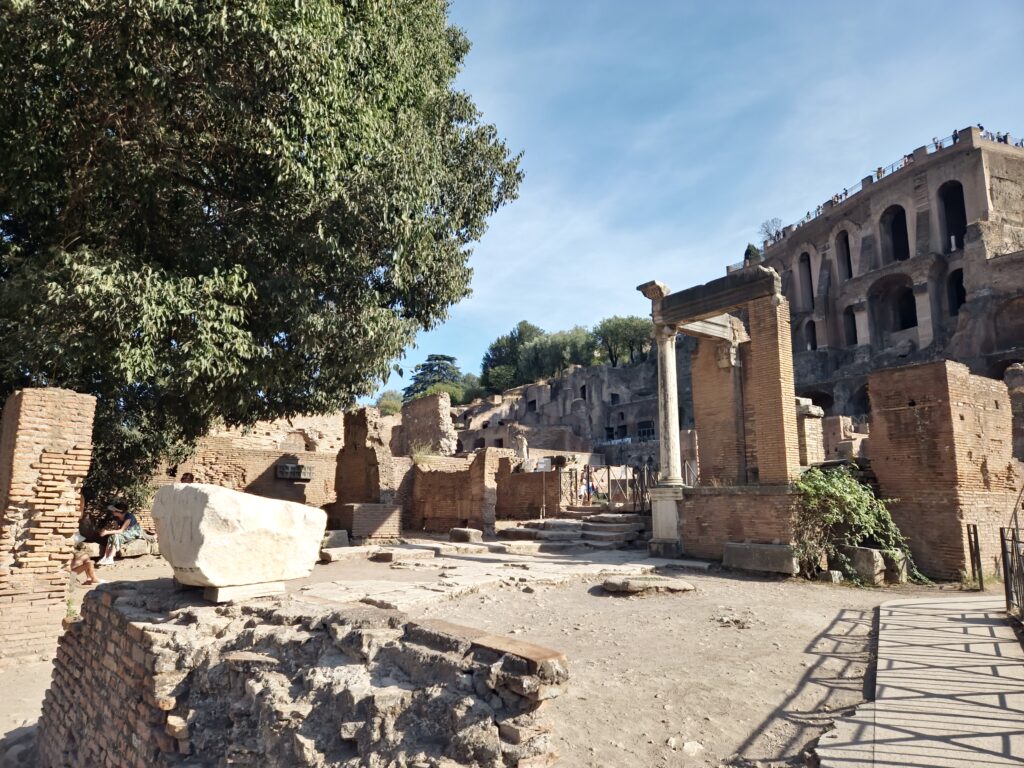
8/25
Venice or Venezia!
Ah, Venice… the city shimmering on the water, an ethereal dream made manifest. Yes, the reality lives up to the romanticized images, the cinematic allure. Stepping off the train after a four-hour journey from Rome, you’re immediately immersed in a world distinct from the Italian mainland.
The train itself was a microcosm of anticipation, a rolling parade of tourists, each clutching oversized suitcases – a foreshadowing of the impending struggle against Venice’s charming, yet challenging, topography. Hundreds of bridges, each a miniature hurdle, awaited, oblivious to the burden of wheeled luggage.
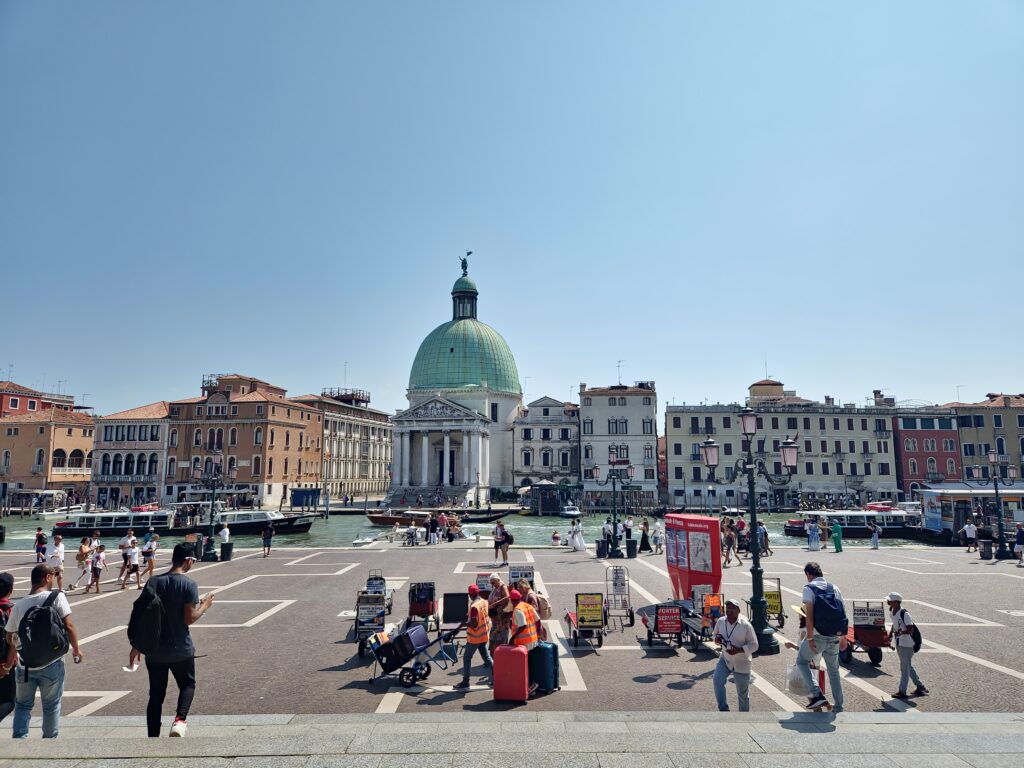
Emerging from Santa Lucia station, the spectacle unfolds. The Grand Canal, a liquid thoroughfare, pulsates with life. Water taxis, like sleek, black beetles, crisscross the waterways, their wakes rippling against the ancient stone foundations. The air hums with a unique energy, a fusion of history and vibrant tourism. It’s a sudden, almost theatrical transformation, as if a curtain has lifted to reveal a stage set unlike any other.
For the next three days, we wandered the labyrinthine streets and canals, and a curious sensation settled in: we were no longer simply in Italy. Venice, with its unique dialect, its distinct architectural style, and its water-centric existence, felt like a sovereign entity, a city-state within a nation. It was a journey into a world where the rhythm of life was dictated by the ebb and flow of the tides, not the bustling streets of Rome.
A word of advice for the shutterbugs: resist the urge to capture that iconic shot at the first bridge you encounter. Venice is a city of hidden corners and quiet moments. Each bridge, each canal, each weathered facade holds its own unique charm. Venture beyond the well-trodden paths, explore the quieter ‘calli,’ and you’ll discover a bridge, a vista, a moment that belongs solely to you, free from the jostling crowds and the pressure of capturing the ‘perfect’ tourist shot. Let Venice reveal its secrets, one tranquil canal at a time.”
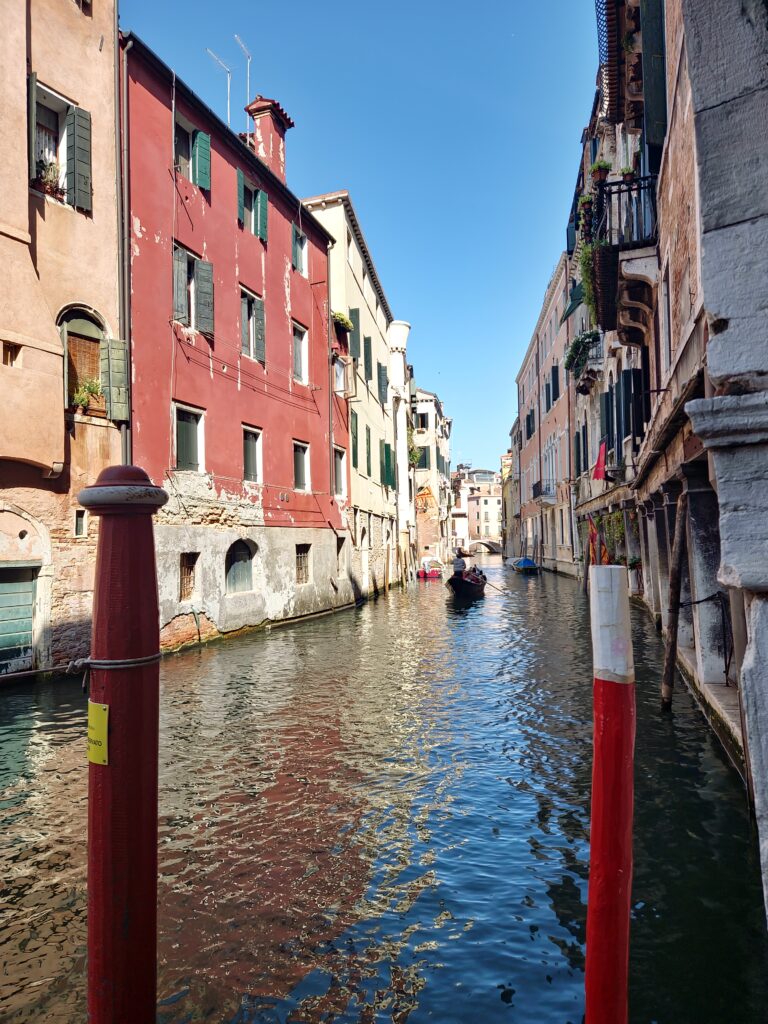
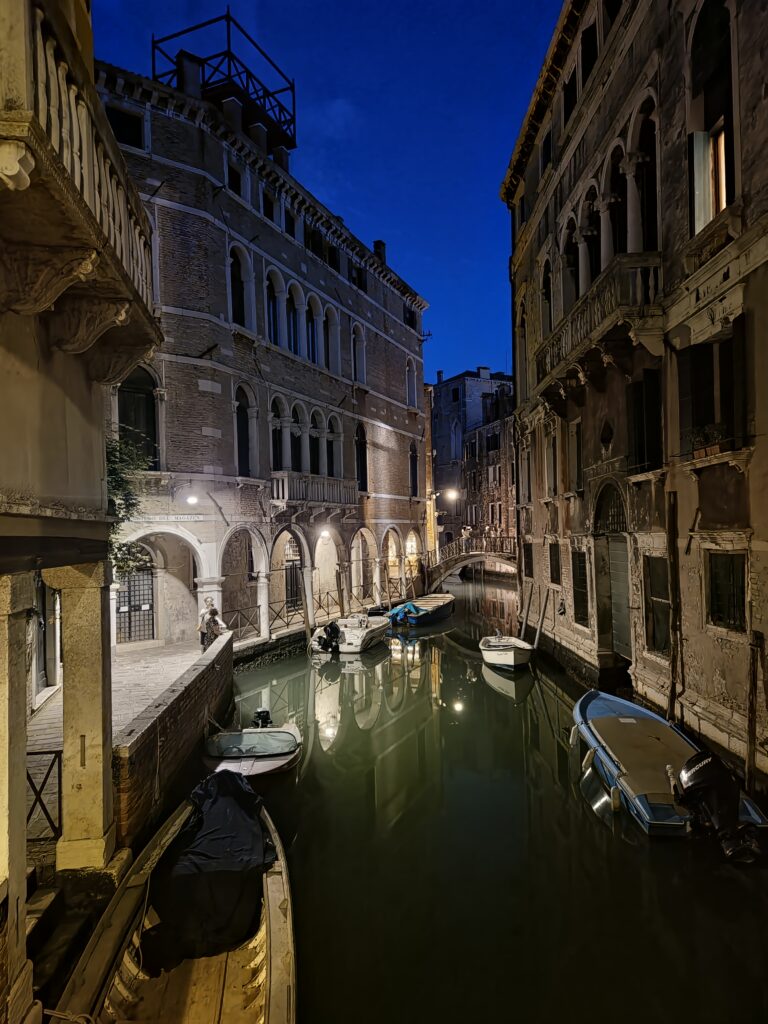
Given our discussion of photography, let’s consider making a reservation at the ‘DFS Fondaco dei Tedeschi’ shopping mall. While you’re welcome to photograph the mall or its merchandise, the real draw is the rooftop observation deck. From there, you could capture stunning 360-degree panoramic views of the city. Best of all, reservations are free, so why not take advantage of this opportunity?
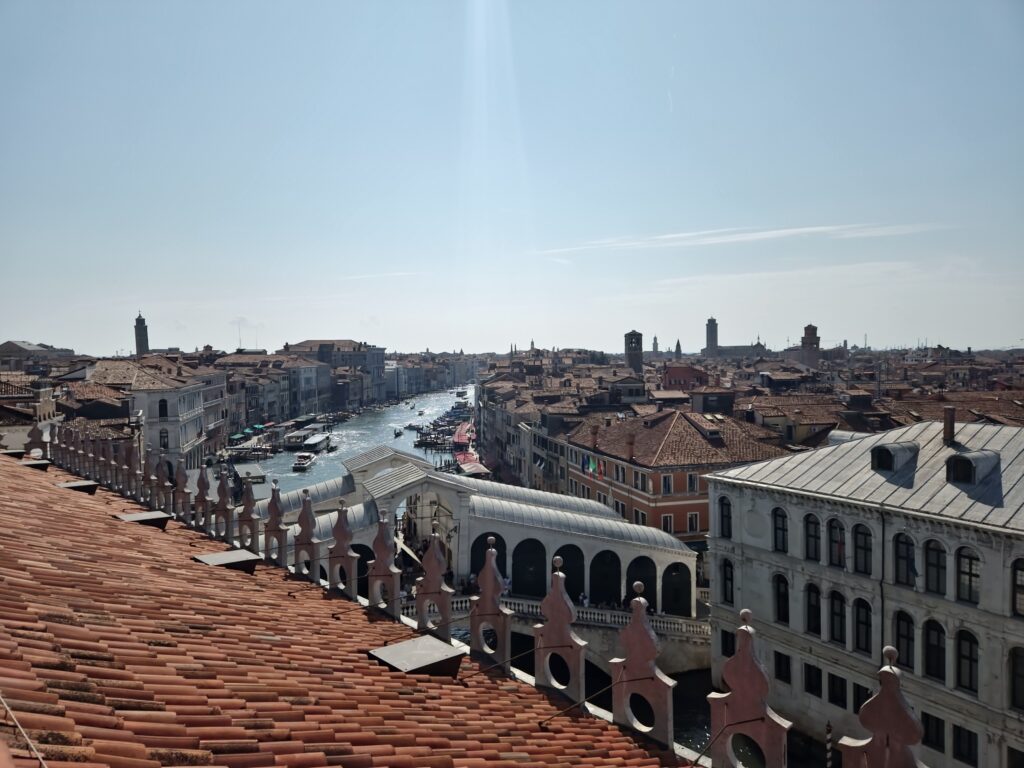
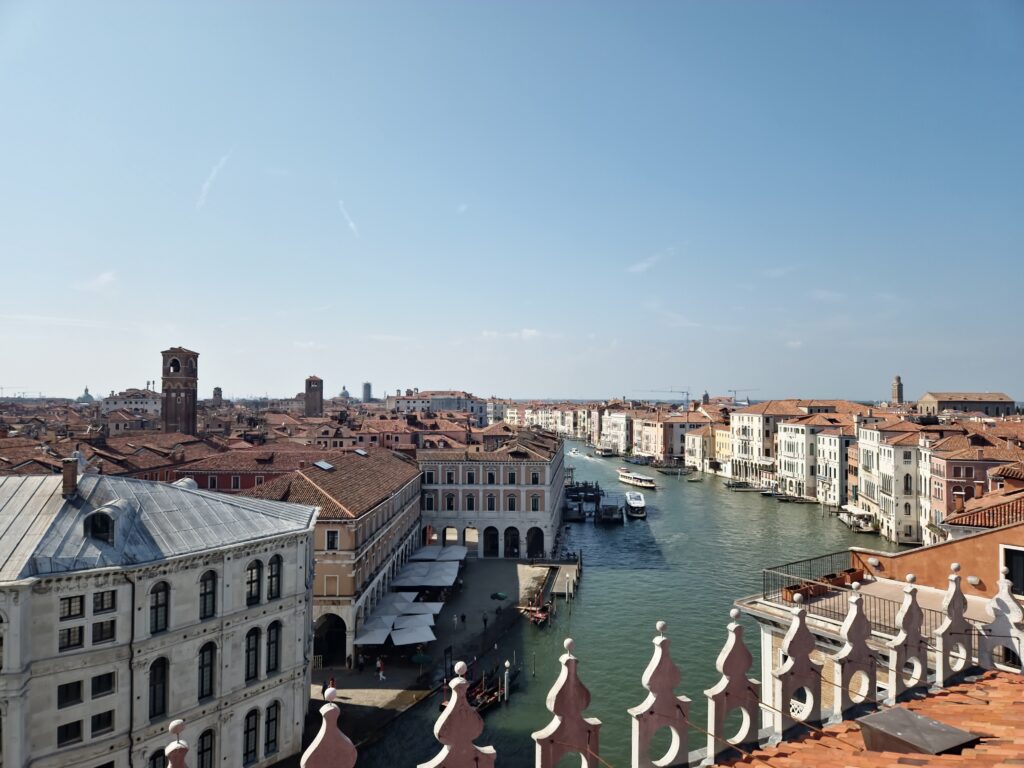
8/26
Island hopping in Venice
Island hopping in Venice? The concept initially seemed as improbable as finding a quiet corner in St. Mark’s Square during peak season. Yet, the Venetian lagoon, a network of islands, offers a fascinating exploration beyond the city’s famed canals.
Today, our journey takes us to Murano and Burano, two islands that reveal distinct facets of Venetian culture.
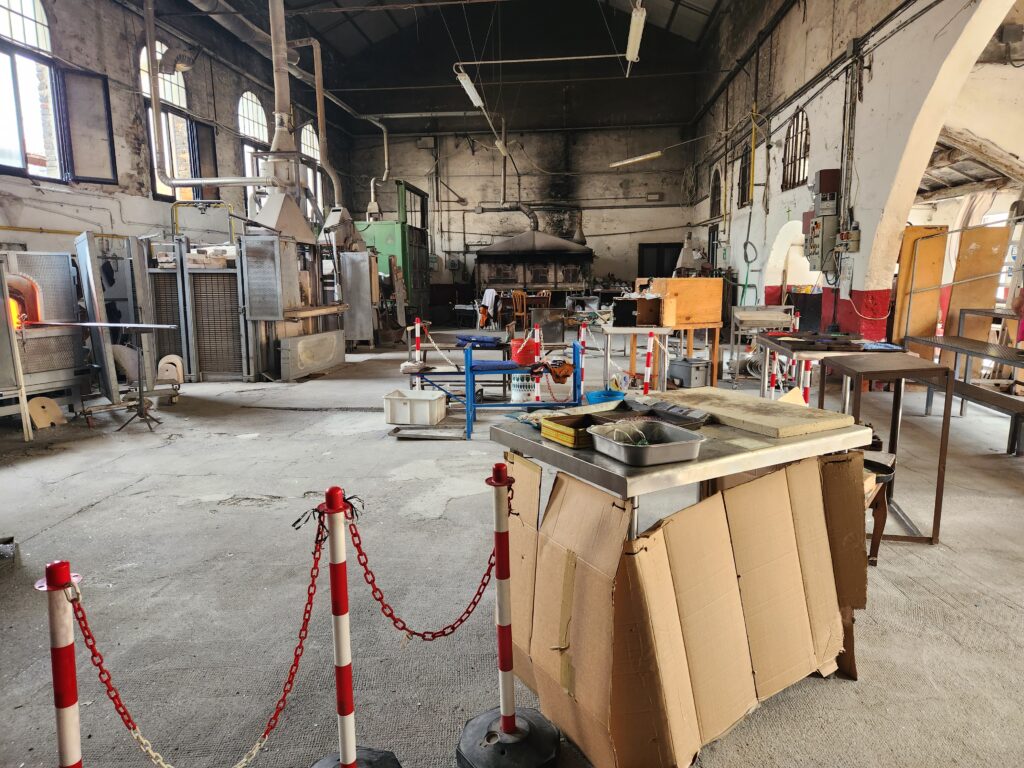
Murano, the epicenter of Venetian glassmaking, is a testament to centuries of artisanal tradition. While Venice markets the exquisite glassware, it’s on Murano that the intricate process unfolds. The island’s furnaces, fueled by generations of knowledge, transform raw materials into delicate masterpieces. Visitors can witness the mesmerizing spectacle of glassblowing, a craft that has been refined and perfected over centuries. The island’s atmosphere is one of focused artistry, a stark contrast to the bustling tourist traffic of Venice itself.
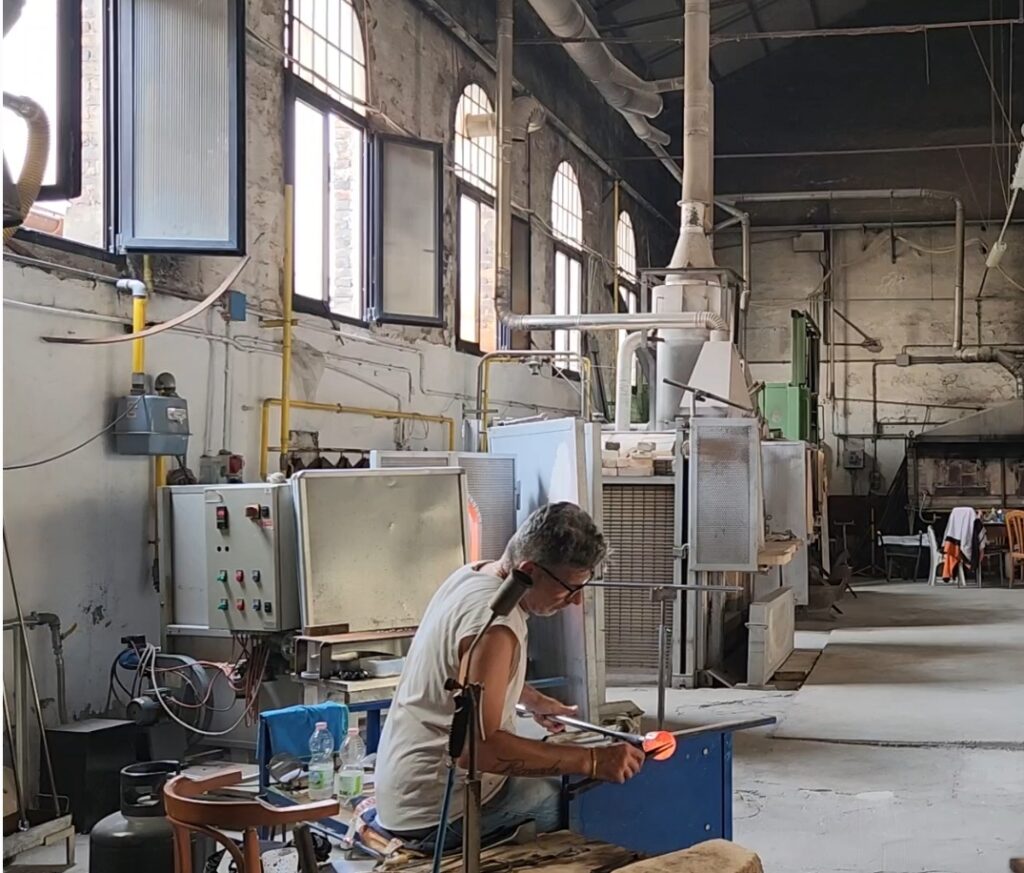

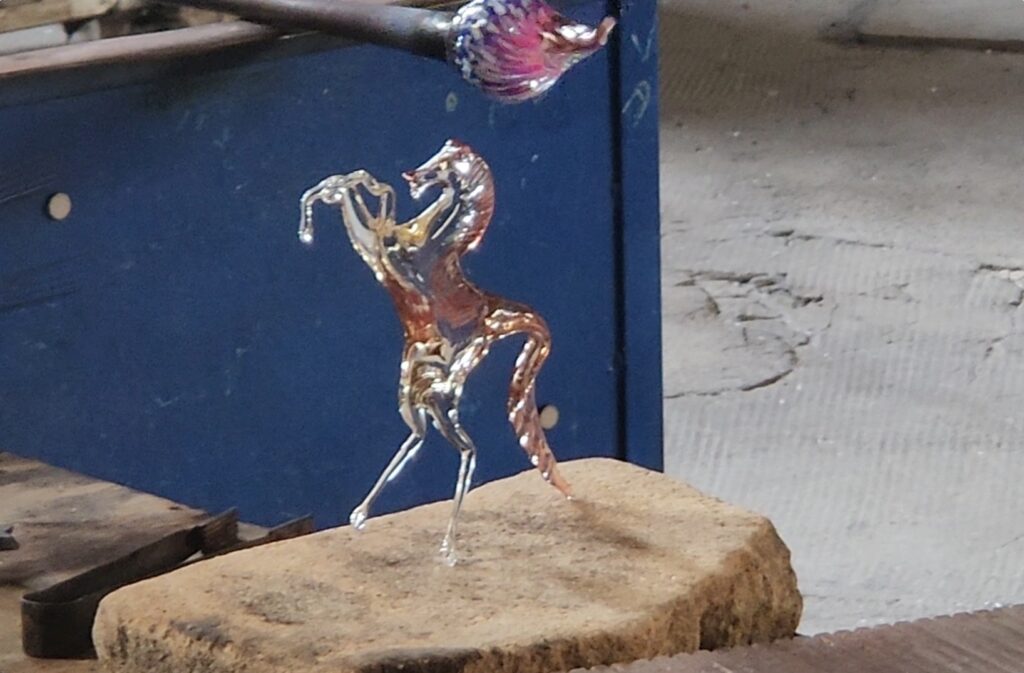
A short vaporetto ride brings us to Burano, a visual feast of vibrant colors. This island, renowned for its brightly painted houses, is a photographer’s dream. The origins of these hues are debated, with some attributing them to fishermen painting their homes in distinct colors for easy identification from the sea. Regardless of their origin, the effect is undeniably enchanting. Each house, a splash of color against the lagoon’s backdrop, creates a picturesque scene. Unlike the dense crowds of Venice, Burano offers a tranquil escape, a place where the pace of life slows down, and the beauty of simplicity takes center stage. It’s easy to see why Burano’s colorful charm has earned it the reputation of an Instagrammer’s haven, a place where every snapshot captures a moment of pure, unadulterated beauty.
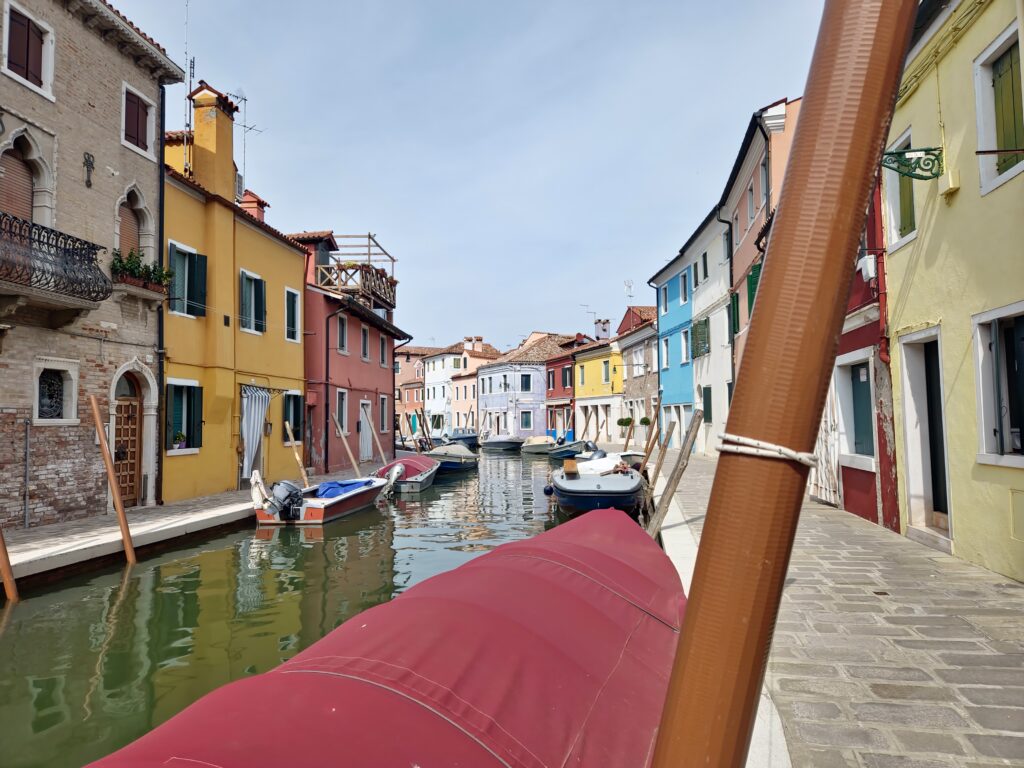
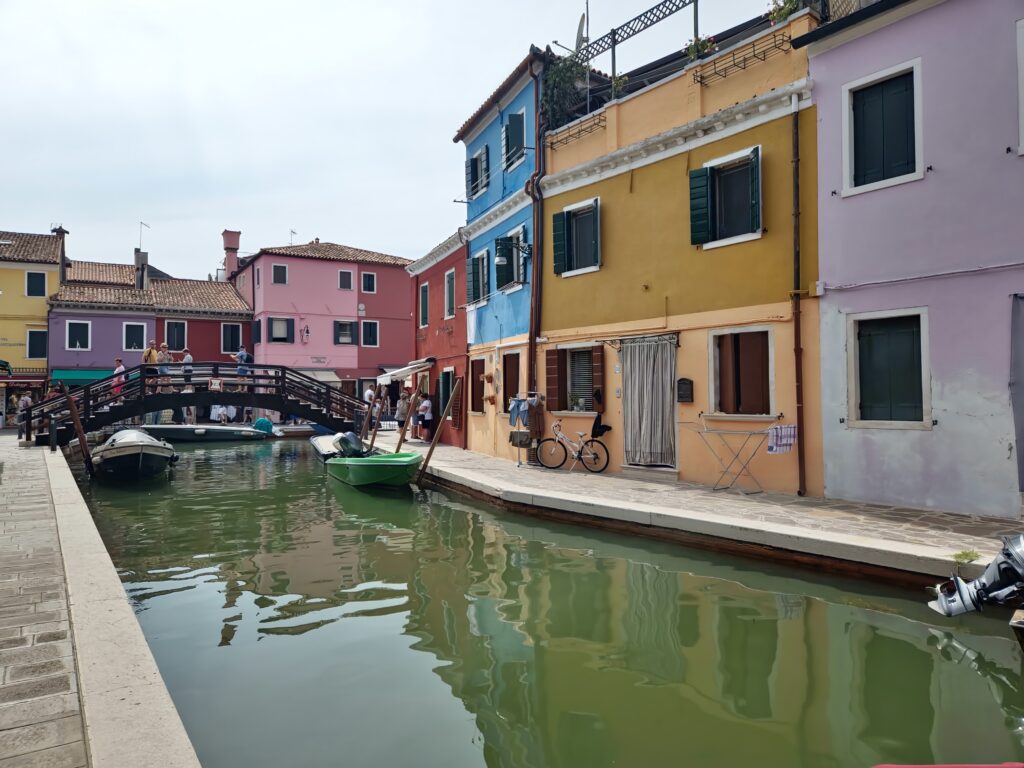
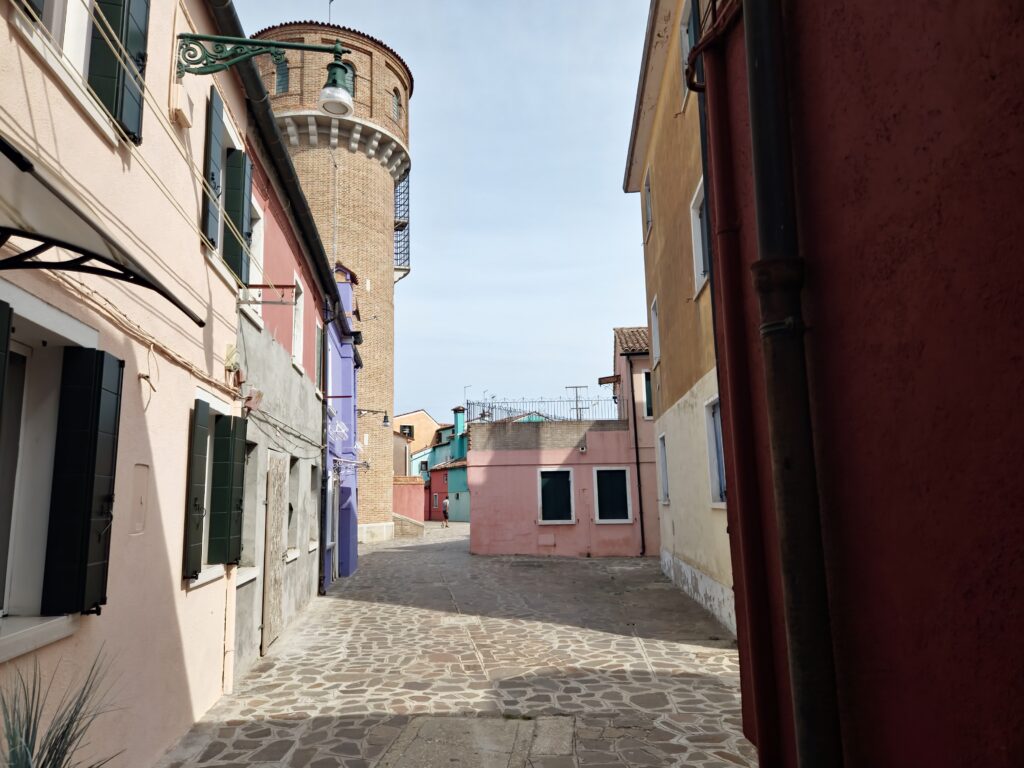
8/27
Last night in Roma
Any good thing will have to end at some point. Our “Roman Holiday” was nearing its close, and we decided to savor our last Italian dinner in the historic Trastevere neighborhood. After leaving Venice around noon and arriving in Rome around 4:30 pm, we checked into our AirBnB, freshened up, and took a bus to the Colosseum. From there, we enjoyed a leisurely stroll to Trastevere, our destination being Tonnarello, a restaurant known for its authentic Roman dishes and a cozy, inviting ambiance. According to Google Maps, Tonnarello boasts a remarkable 4.7-star rating with over 79,000 reviews! The promise of incredible food was enticing, even if it meant a potential wait.
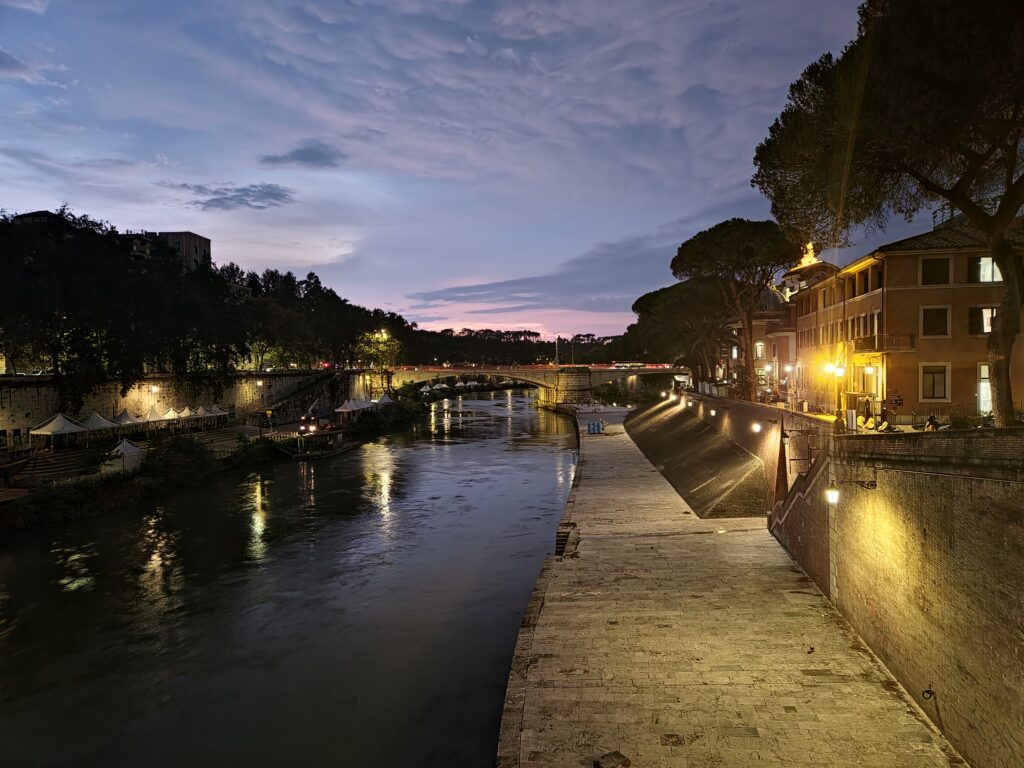
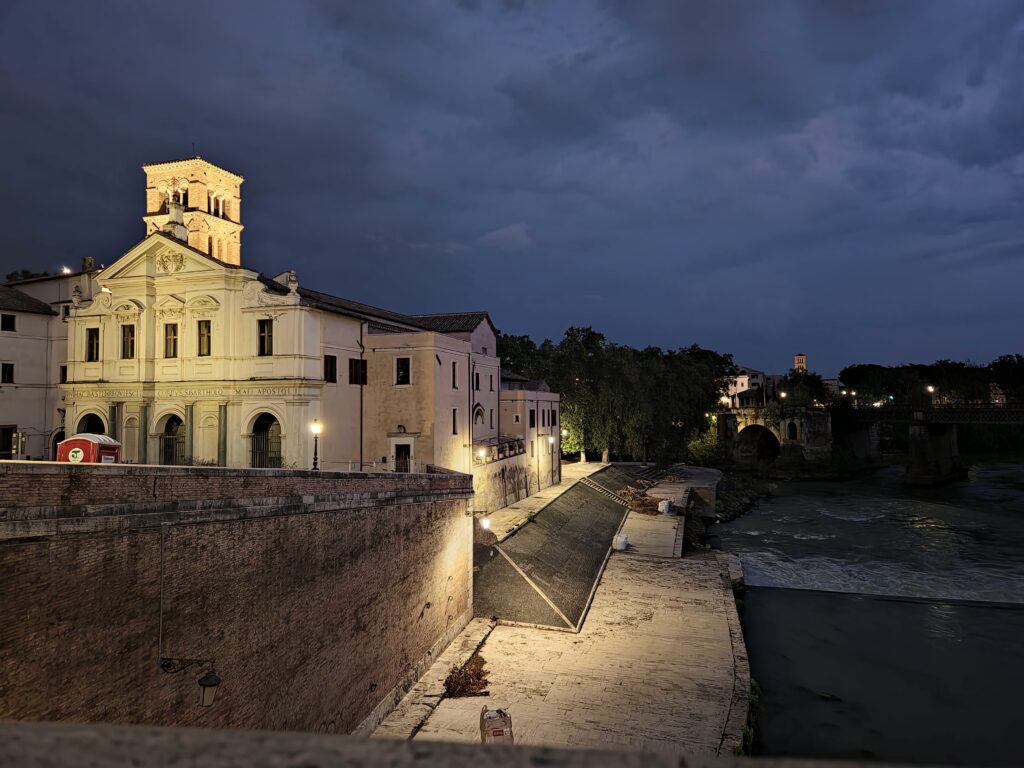
As we entered Trastevere, we found ourselves on Via della Lungaretta, a picturesque street with a rich history dating back to the 2nd century BC. This lively thoroughfare, once a pilgrim path to the Vatican, was lined with shops and restaurants, each offering a tempting glimpse of the culinary delights within. The aroma of Italian cooking filled the air, making it easy to be distracted by the delicious-looking dishes on display.
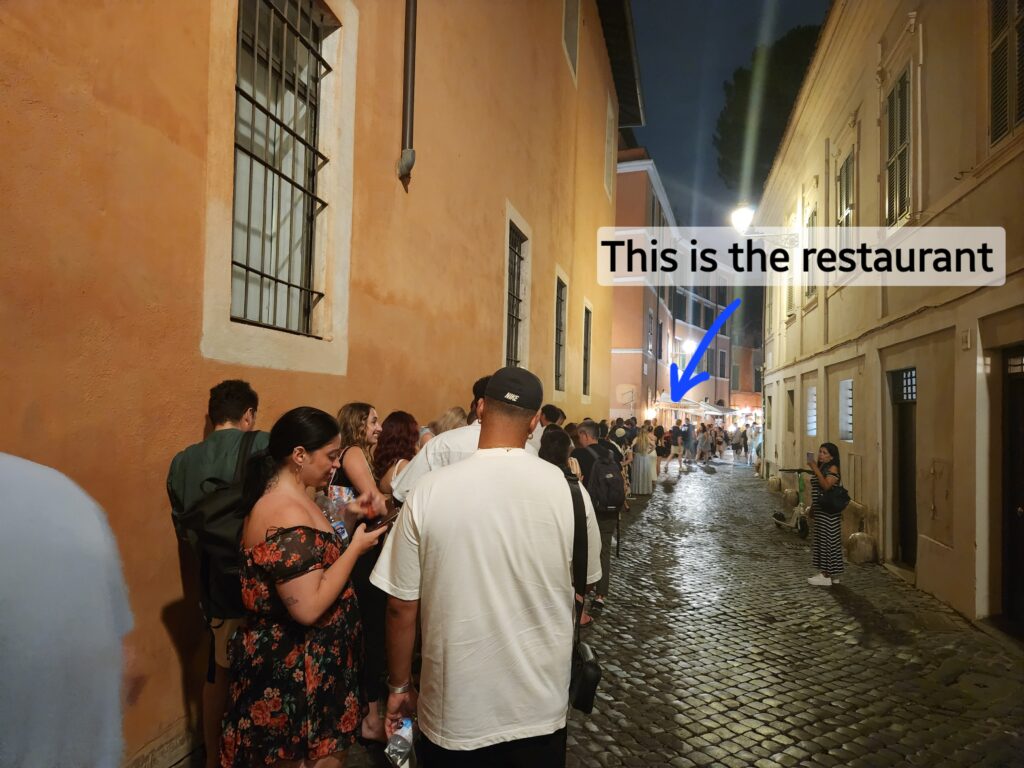
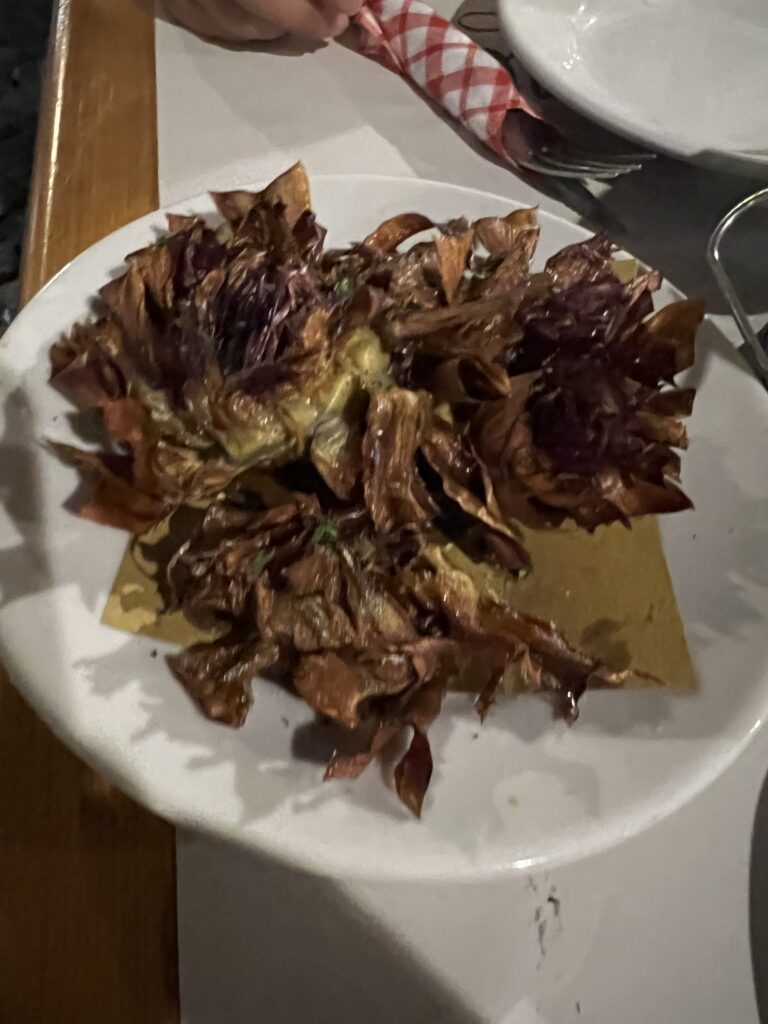
Finally, we arrived at Tonnarello, hungry and eager, only to be met with a long line and an estimated hour-and-a-half wait. Normally, we might have walked away, but the restaurant’s impressive reputation and those 79,000+ reviews intrigued us. To make a long story short, the food was indeed incredible, and we could easily see why the rating was so high.
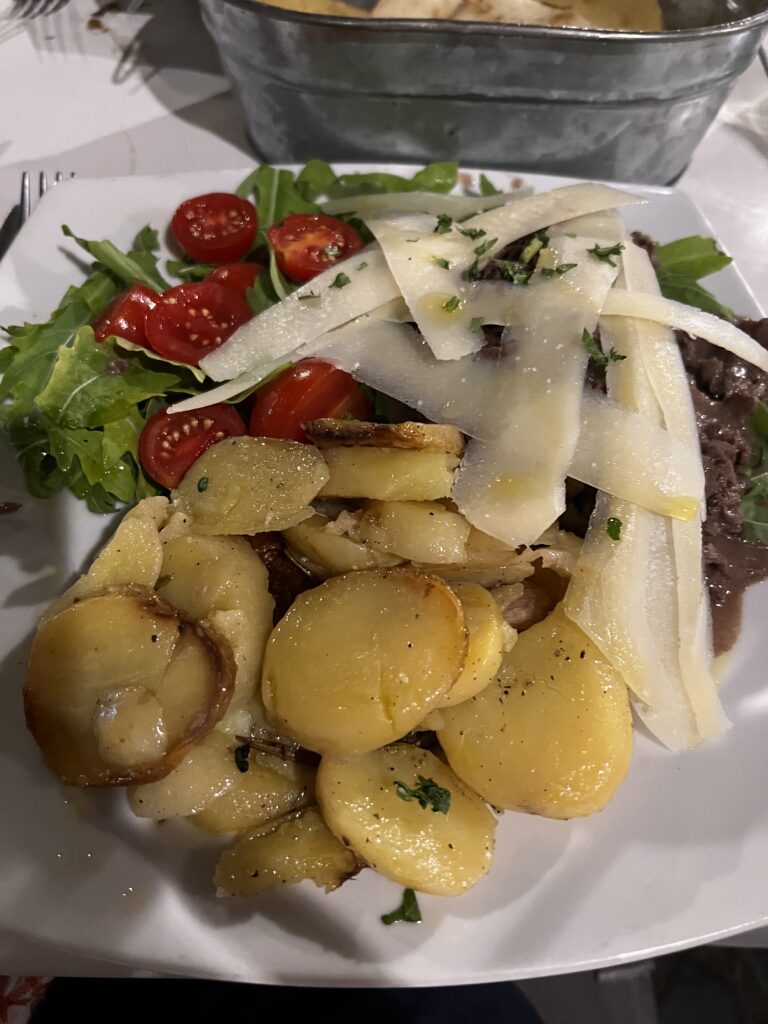

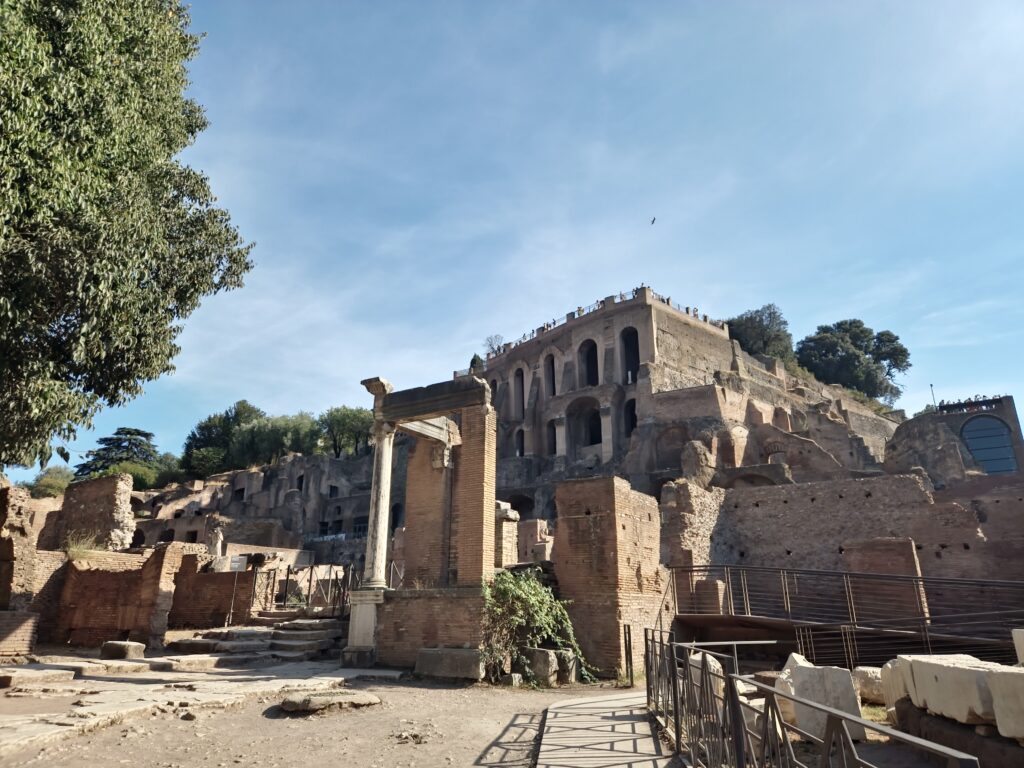
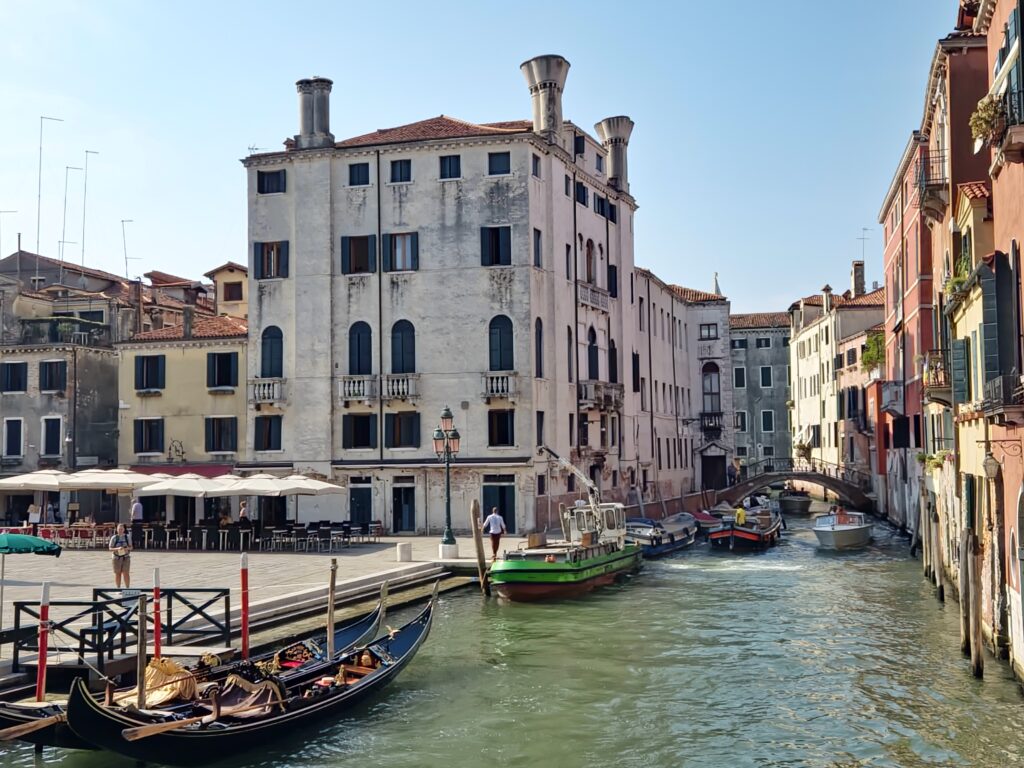
As we strolled back to our AirBnB, the ancient stones beneath our feet seemed to hum with the weight of centuries. Our eyes, heavy with the day’s wonders, lingered on every timeworn structures, every sun-drenched piazza. A palpable sense of history enveloped us, a tangible presence that resonated with echoes of bygone eras.
We could almost hear the spectral roar of the Colosseum’s gladiatorial contests, the phantom cheers of a captivated audience. Down the winding Via Sacra, leading to the Roman Forum, we conjured the vibrant spectacle of toga-clad senators and bustling merchants, the very heart of the Republic’s power.
Further still, our minds drifted to the shimmering canals of ancient Venice, where sleek galleys, laden with silks and spices, glided effortlessly on the trade winds, connecting East and West. And then, there was the profound devotion that drew countless pilgrims to Vatican City. We imagined the throngs of faithful, their faces illuminated with hope, embarking on their sacred journey, yearning for a fleeting glimpse of the Pope, a moment of spiritual grace. To many, a sojourn to Italy is more than a vacation; it’s a pilgrimage of the soul, a chance to touch the very essence of human history and artistry.
We felt an overwhelming sense of gratitude, a deep humility, to be able to transform this lifelong dream into a tangible reality, to walk amidst the ghosts of emperors and artists, saints and scholars, and to witness the enduring legacy of a civilization that shaped the world.
